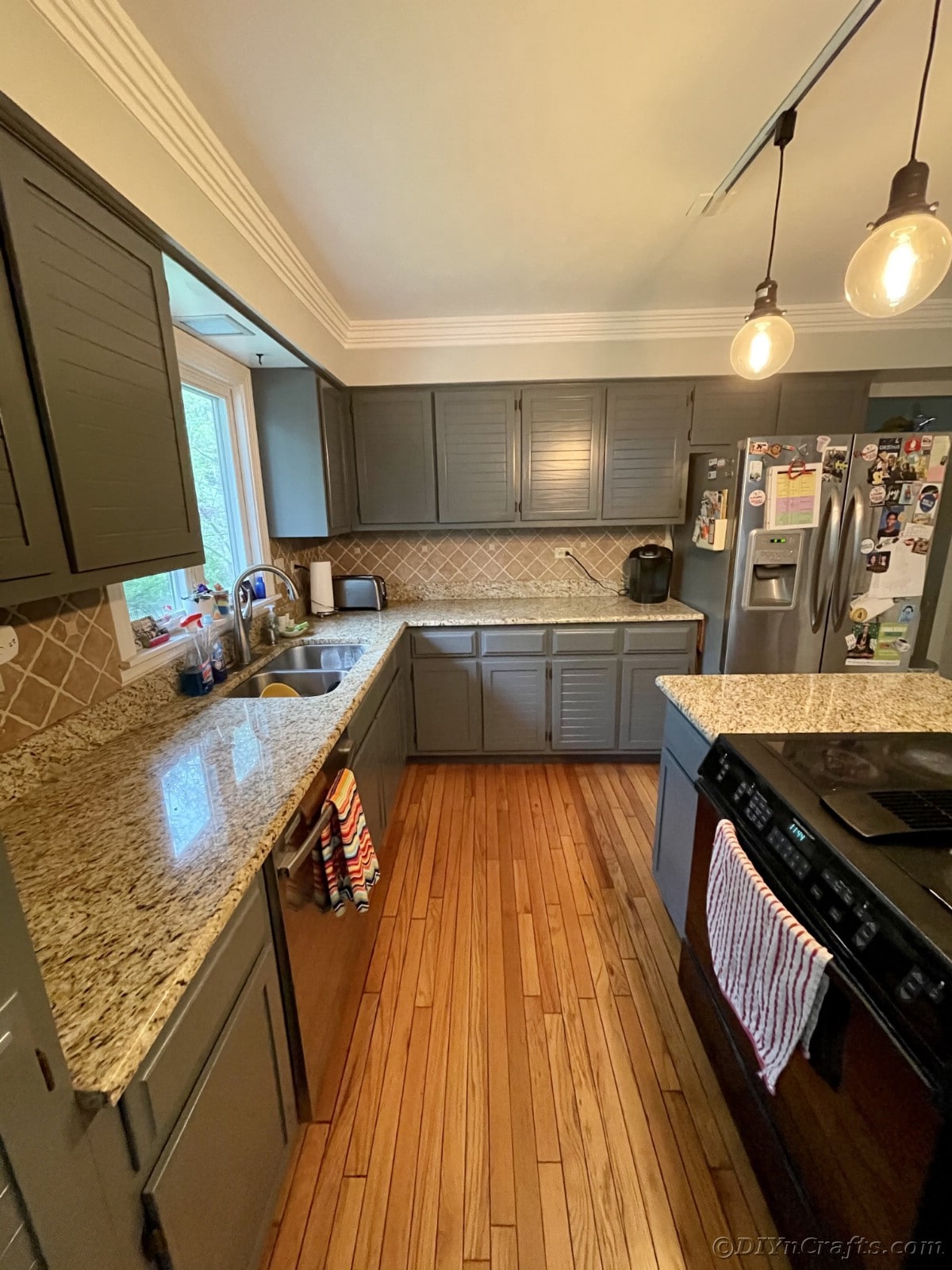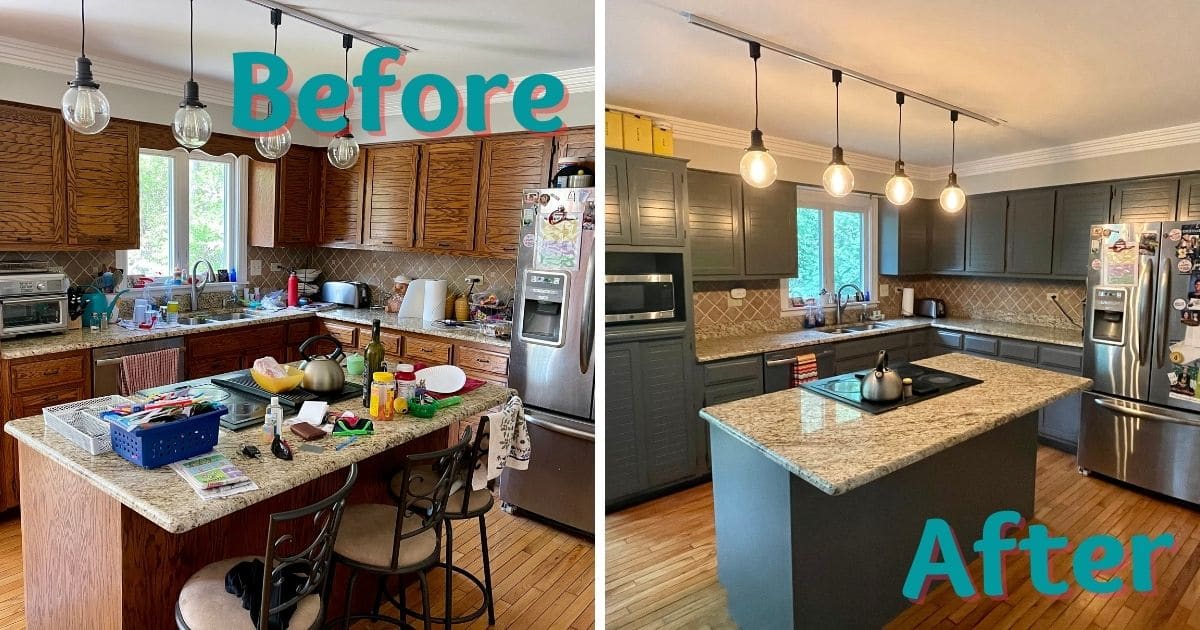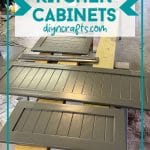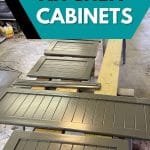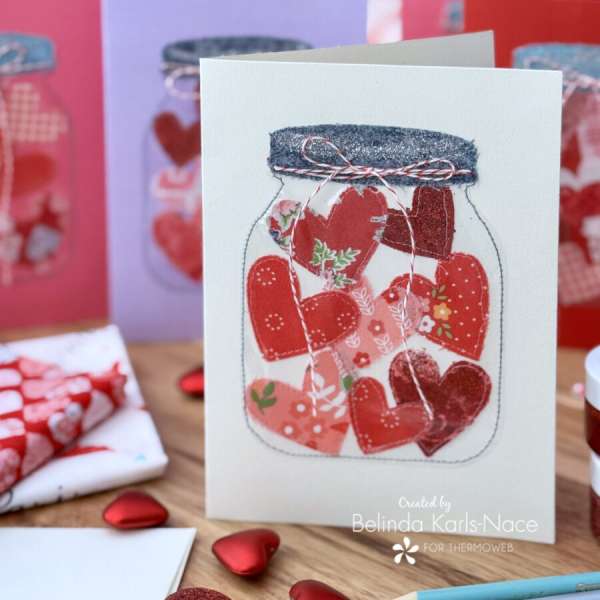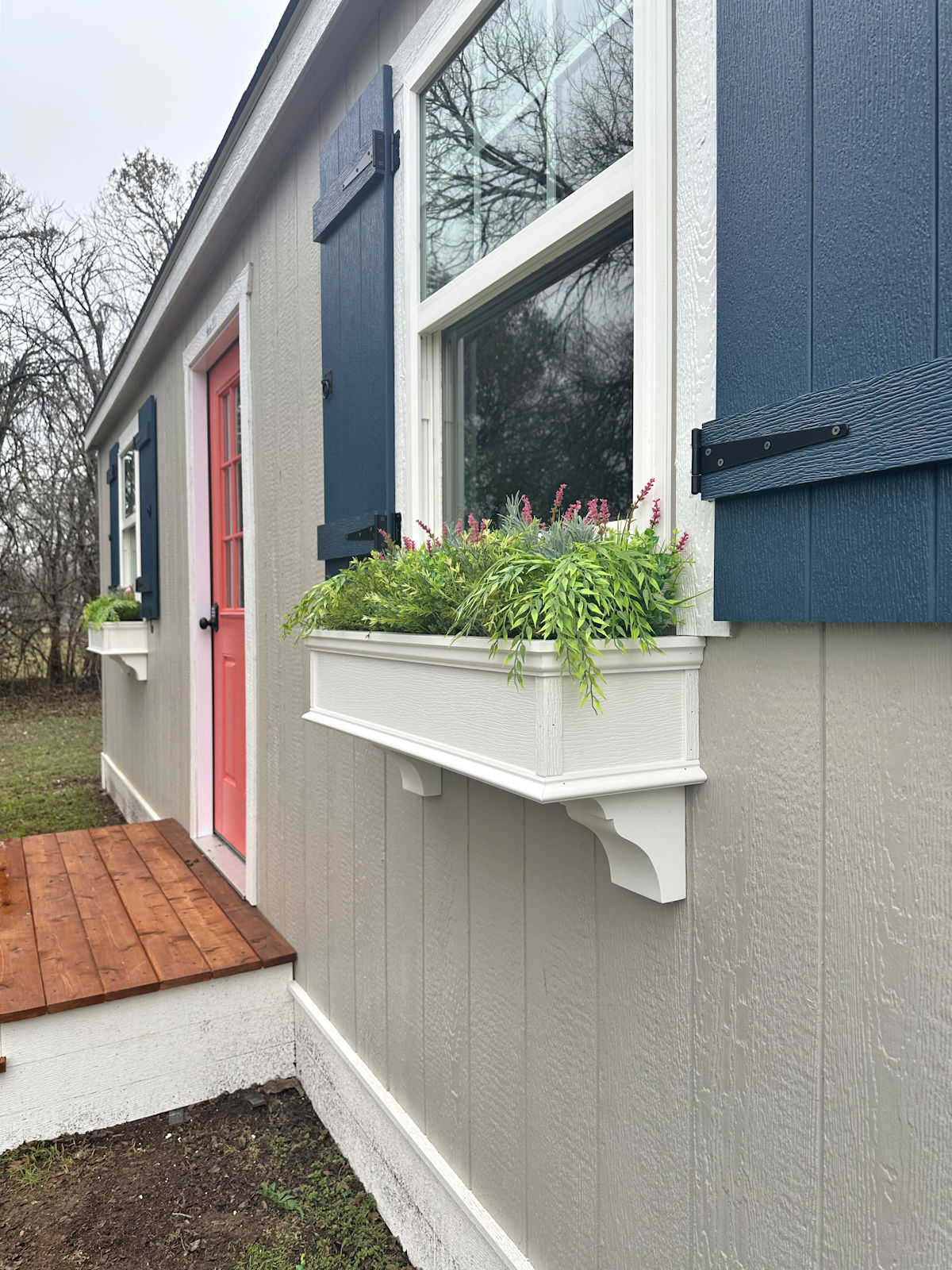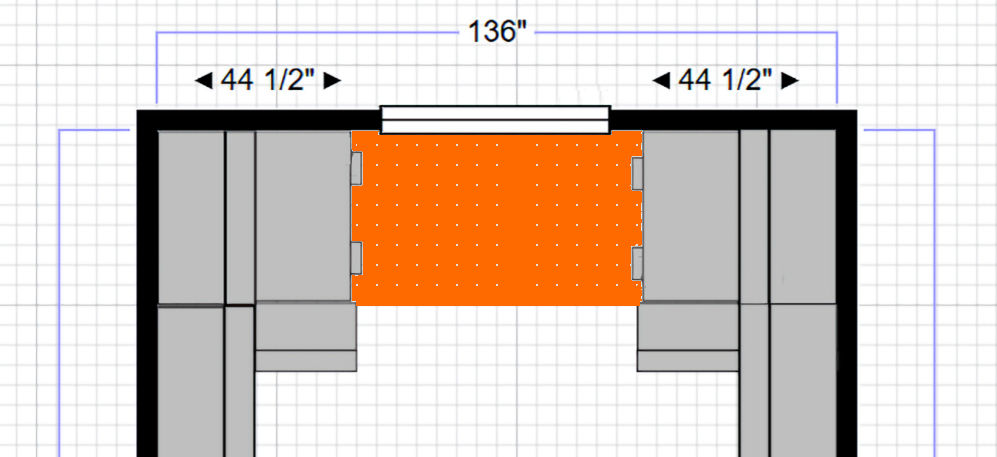Are you stuck in an older house that has blah or old-fashioned kitchen cabinets? This kitchen cabinet painting tutorial is the perfect restoration for you to draw inspiration from for your own kitchen. A little change in the look of your cabinets can actually be a total revamp of your entire kitchen. Whether you do this alone or alongside updated appliances, it’s sure to be a fun and amazing project!
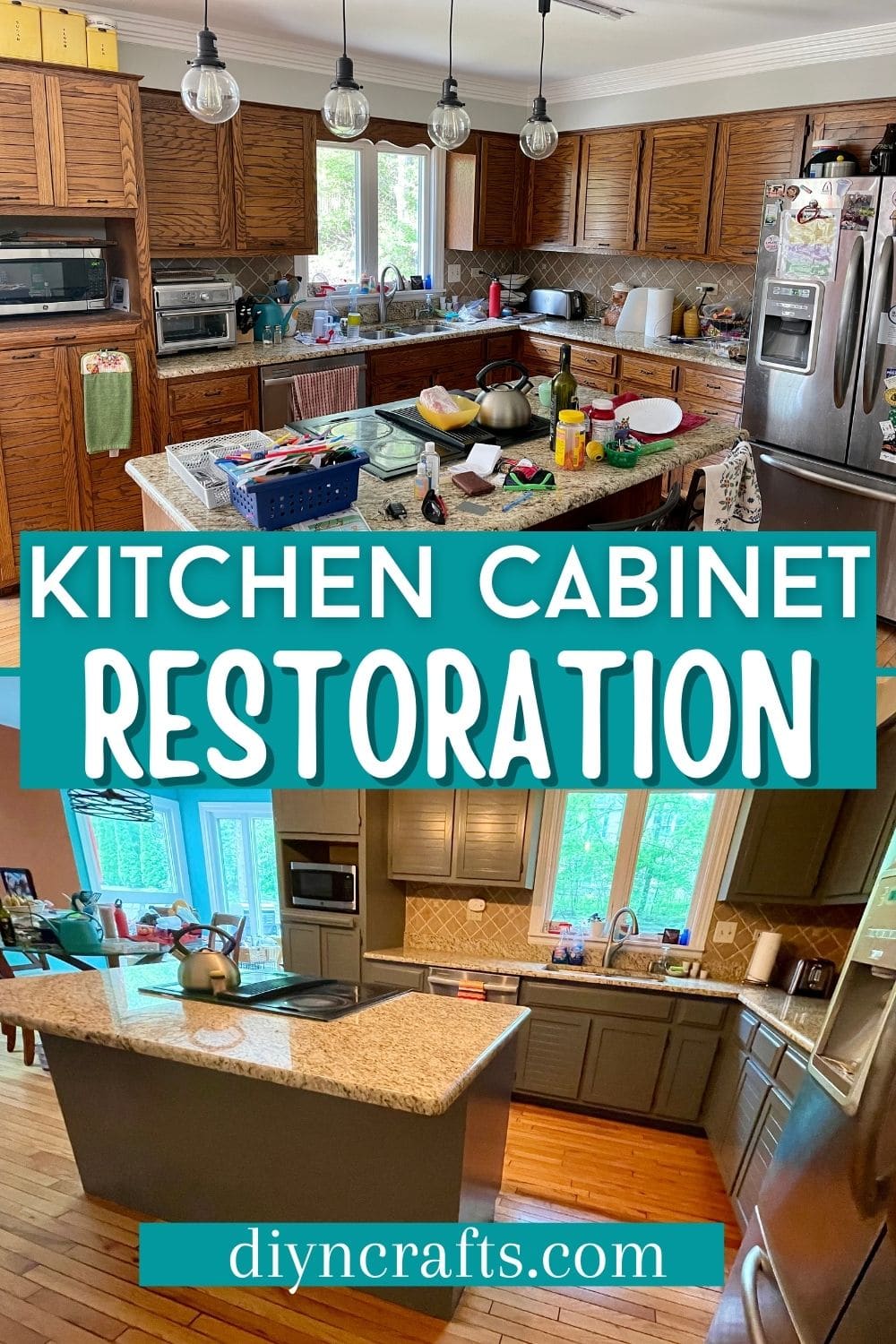
Kitchen Cabinet Painting Tutorial
Simple and easy is the way I go when it comes to renovations or restorations. I want to see a beautiful end result, but in the process, I want easy-to-follow steps. It’s also important to me that I have budget-friendly supplies. While the supply list may be rather long, most of the supplies you may already have on hand or can get for a fairly affordable price. This kitchen cabinet painting tutorial will help you turn any kitchen into a gorgeous modern oasis!
More DIY Projects to Try
If you want to dive into restoration and distressing, there are some other great ideas below to check out. From turning an old table into something new or just updating to a new color, these DIY projects are fun and easy to follow.
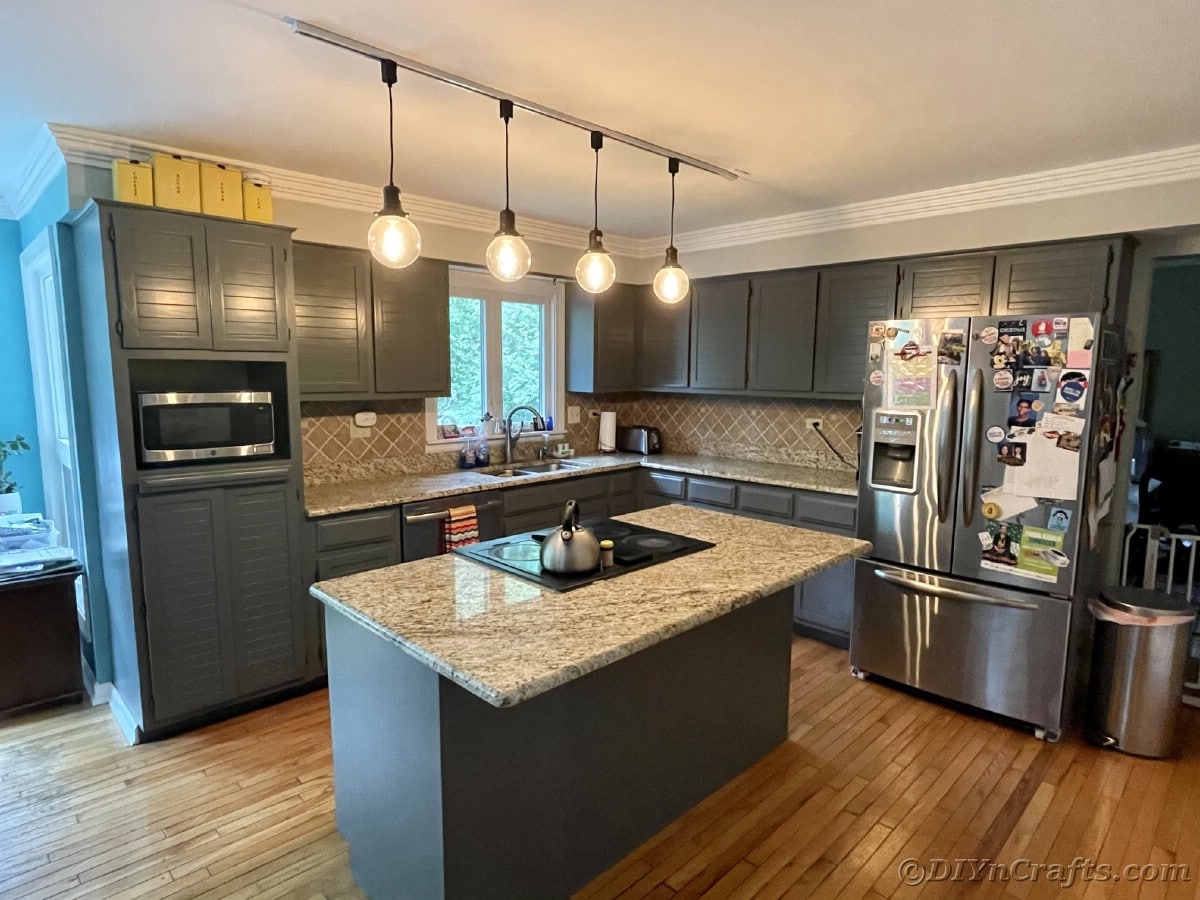
Supplies Needed
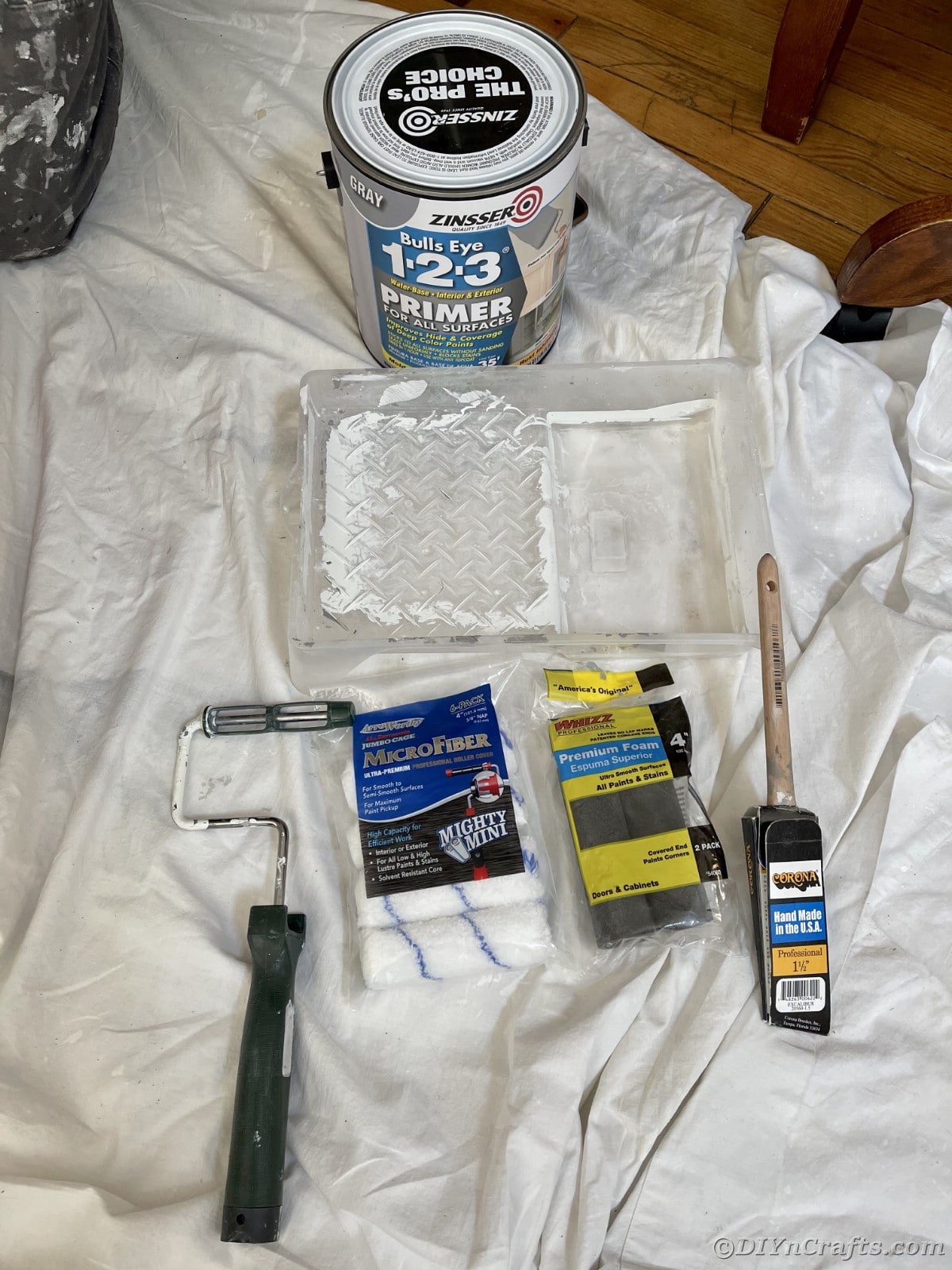
Tips Before You Begin
Before you begin making the changes to your kitchen, you will have some prep work to do. Below are some tips to consider before you begin tackling what will be a sizable project.
- Set aside a few days when you won’t need to have your kitchen fully functional. While it will mostly be work on the cabinet doors and drawers, you will need to let things dry completely.
- Create a marking system for each drawer and cabinet door before you remove them. Assembling everything after the paint has dried may be difficult if you don’t have the right items going back into the right places. Photographs or small marks on the interior with a pencil can work great.
There are some others that are important for the actual work, not just before you begin. Keep these things in mind so you have the best possible result.
- When cleaning the cabinets, doors, baseboards, drawers, and anything to be painted, be detailed and make sure all grease and dust are removed. Grease can get into strange places in the kitchen, so pay attention closely.
- When sanding the items before you prime them you will want to use elbow grease. Really get into it to get the best smooth finish to ensure the paint lays as smooth as possible. Be sure to also remove stickers or cabinet protectors and fill in any cracks, dents, or hardware holes with wood caulk before priming.
- Make sure you follow the paint manufacturer’s directions in regards to drying time. It may take up to 7 days for everything to dry completely and be hung in place again.
- While you may be able to hang the cabinets back in place once the paint has dried, but you do need to allow it to cure for 30-days before using any cleaning solution on the painted surfaces.
How to Set Up Your Work Space
Set up a large area to not just paint, but allow your pieces to dry properly before you hang them. I recommend a garage or shop where you can lay everything out and shut it away so nothing gets on it before it dries. It’s important to plan ahead so it won’t have a lot of people walking around or the potential for it to be damaged before it dries.
Sweep out the area you are using and pick up anything that may be on the floors or could cause dust or debris to fall onto your freshly painted items.
Place drop cloths or plastic on the floors and walls to protect the space from any paint drips or spray. Painters tape or duct tape can be used to secure it. This is good for keeping the walls and floor from being painted accidentally by overspray.
Place crates or boxes in the center of your spraying area. This will be used when you spray your cabinet doors and drawers. I recommend either making sure you have something set up so you aren’t worried about it being damaged or painted over. It needs to be sturdy enough to hold the pieces and not topple over.
Set up your saw horses and 2×4 boards so that the pieces can lay flat while drying. It works best with one sawhorse on each end and one in the middle. Just make sure you have enough room for every piece to dry whether on the 2×4 or on a box or the ground with plastic underneath.
Cover your kitchen countertops, floors, and appliances with drop cloths or flat sheets to protect them from any dripping paint. Frogger Painters Tape is best for holding these things in place without damaging them when removed.
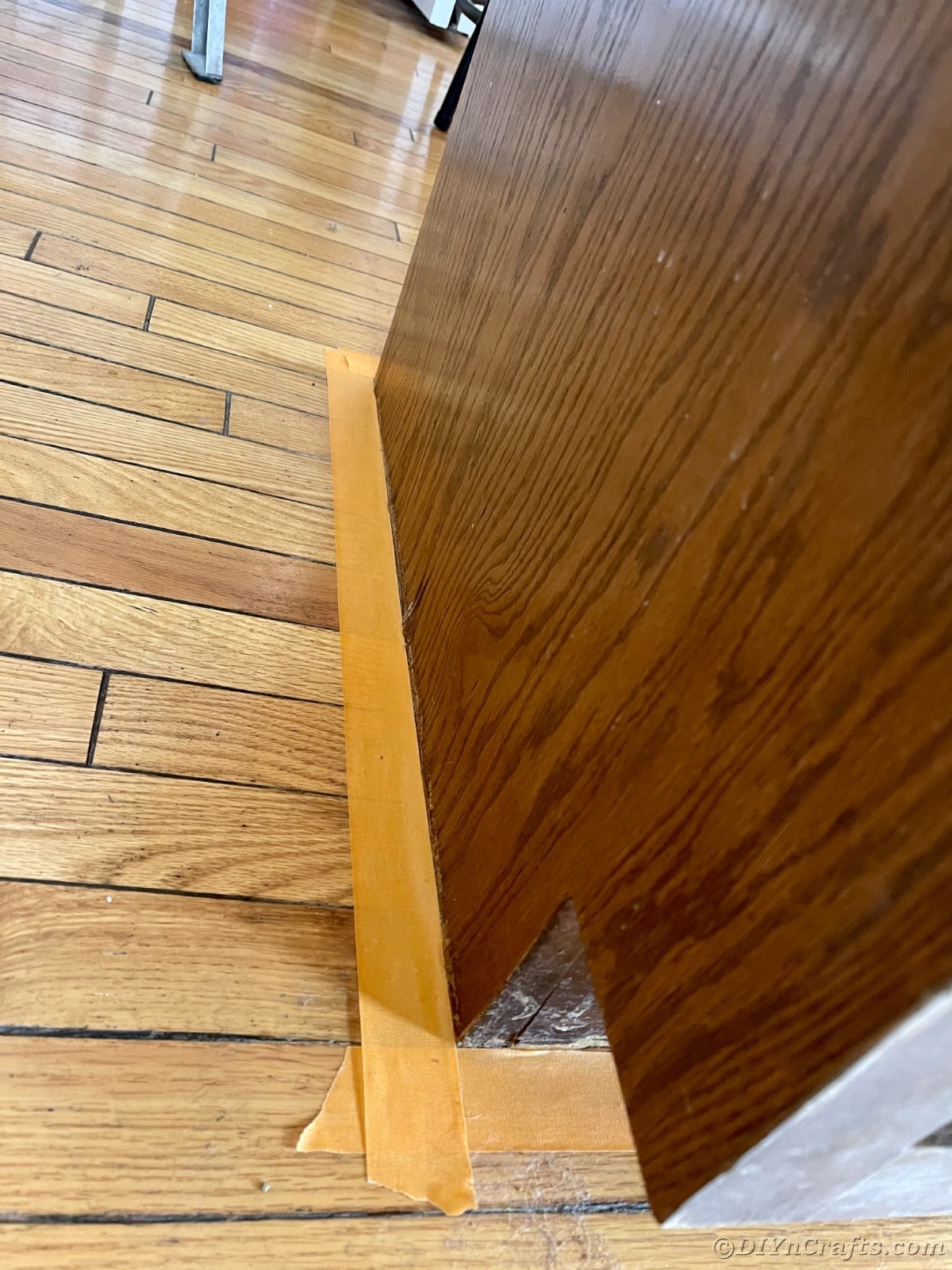
You may also want to use this over any parts of the cabinets you don’t want to be painted.
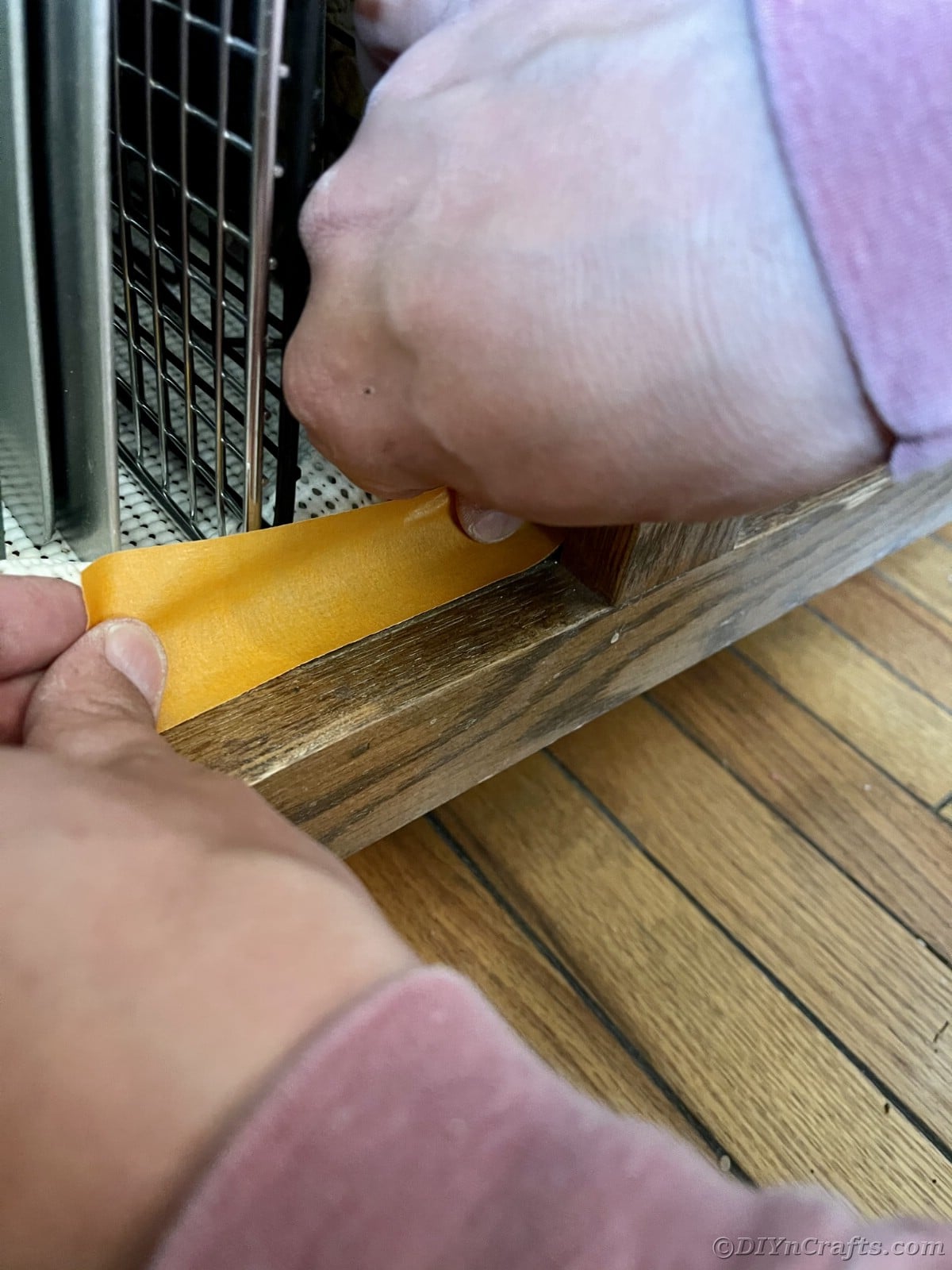
Removing the Kitchen Drawers and Doors
Measure, mark, or take note of each of the cabinet doors and drawers so you know where they will go back after being painted. A diagram and numbering them is helpful.
Use a power drill to remove all of the cabinet doors. Be careful to remove all hinges and make sure you take notes of how to assemble them again. Taking pictures, making a diagram, or marking these is important to make sure everything goes back exactly where it came from. Place the hinges and hardware into the cabinet itself to keep it handy for hanging later.
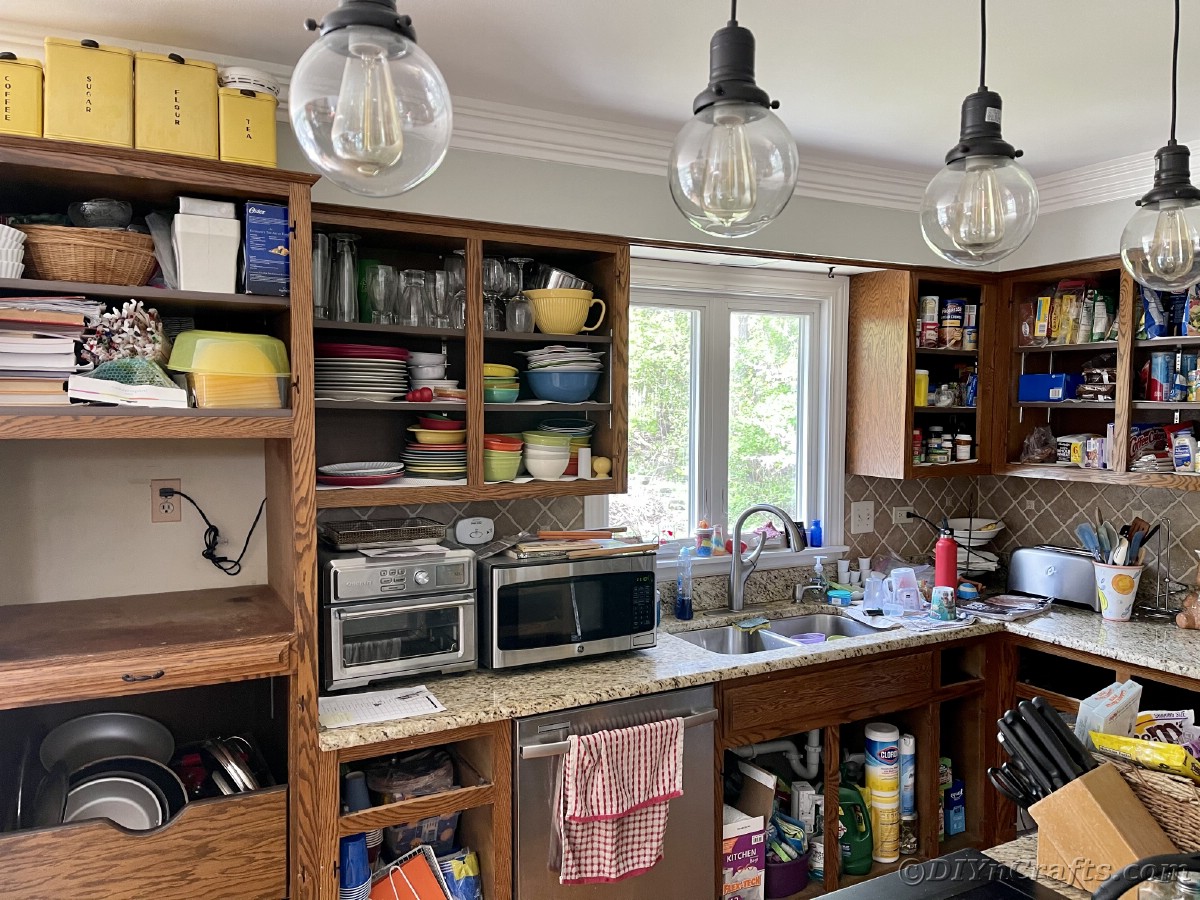
Remove all drawers completely being careful to make note of where they go in the cabinetry. Remove any hardware and place it back into the drawer it belongs to for safekeeping. Take the doors and drawers to the area you have designated for working.
Cleaning and Sanding Cabinets
Prepare yourself by adding a face mask or respirator, and gathering your rags and mineral spirits. If possible, you will also want to open windows for ventilation while using mineral spirits.
Begin working top to bottom, and wipe down all cabinet bases, floorboards, and trim around the kitchen. Use the mineral spirits as needed and remove all grease, food, or debris.
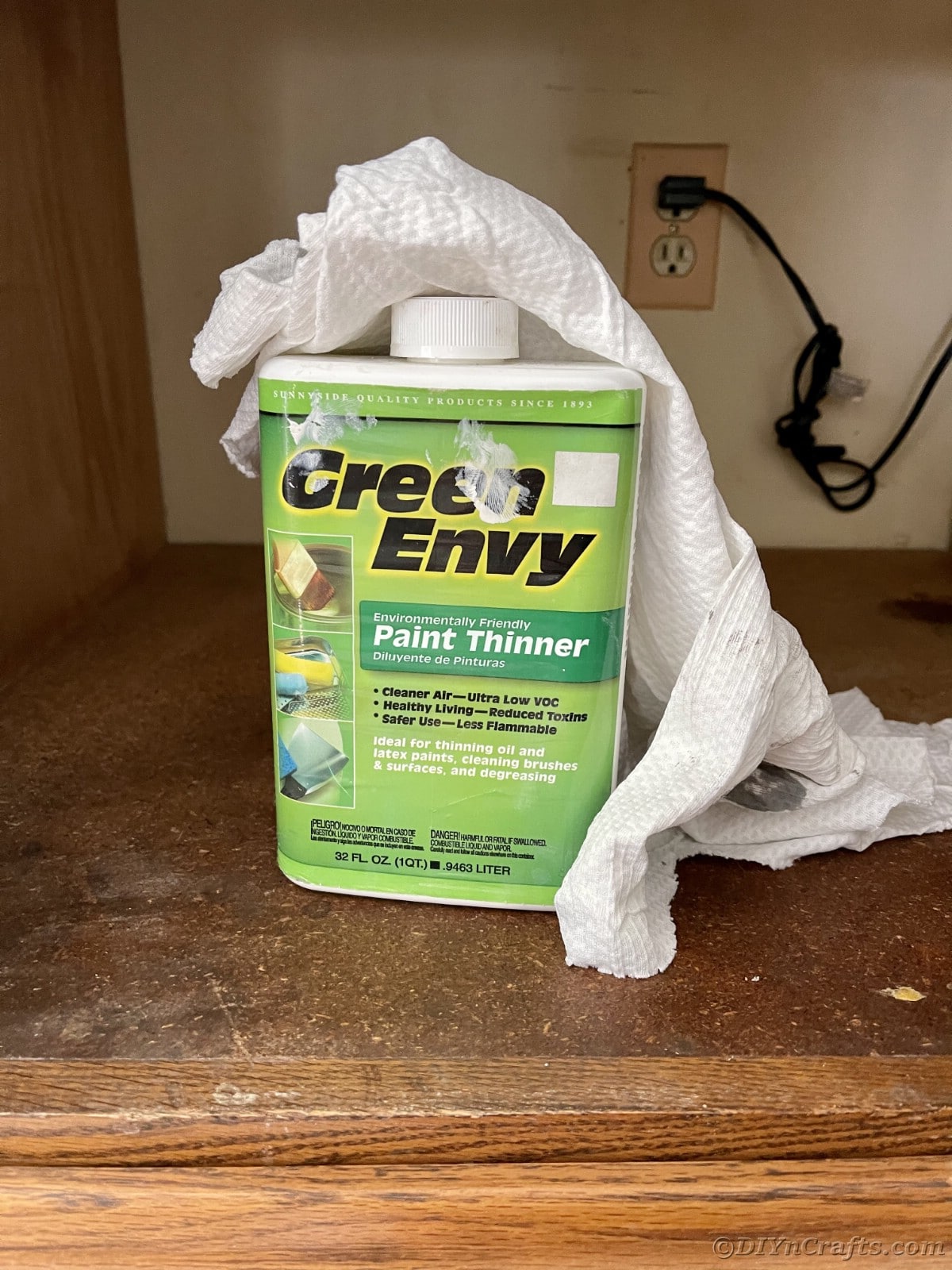
You will also want to remove any stickers or glue on the cabinets using a scraper tool. Mineral spirits also work well on unwanted sticky residue. Go over everything twice to make sure you are getting all of the little bits of dust and grim.
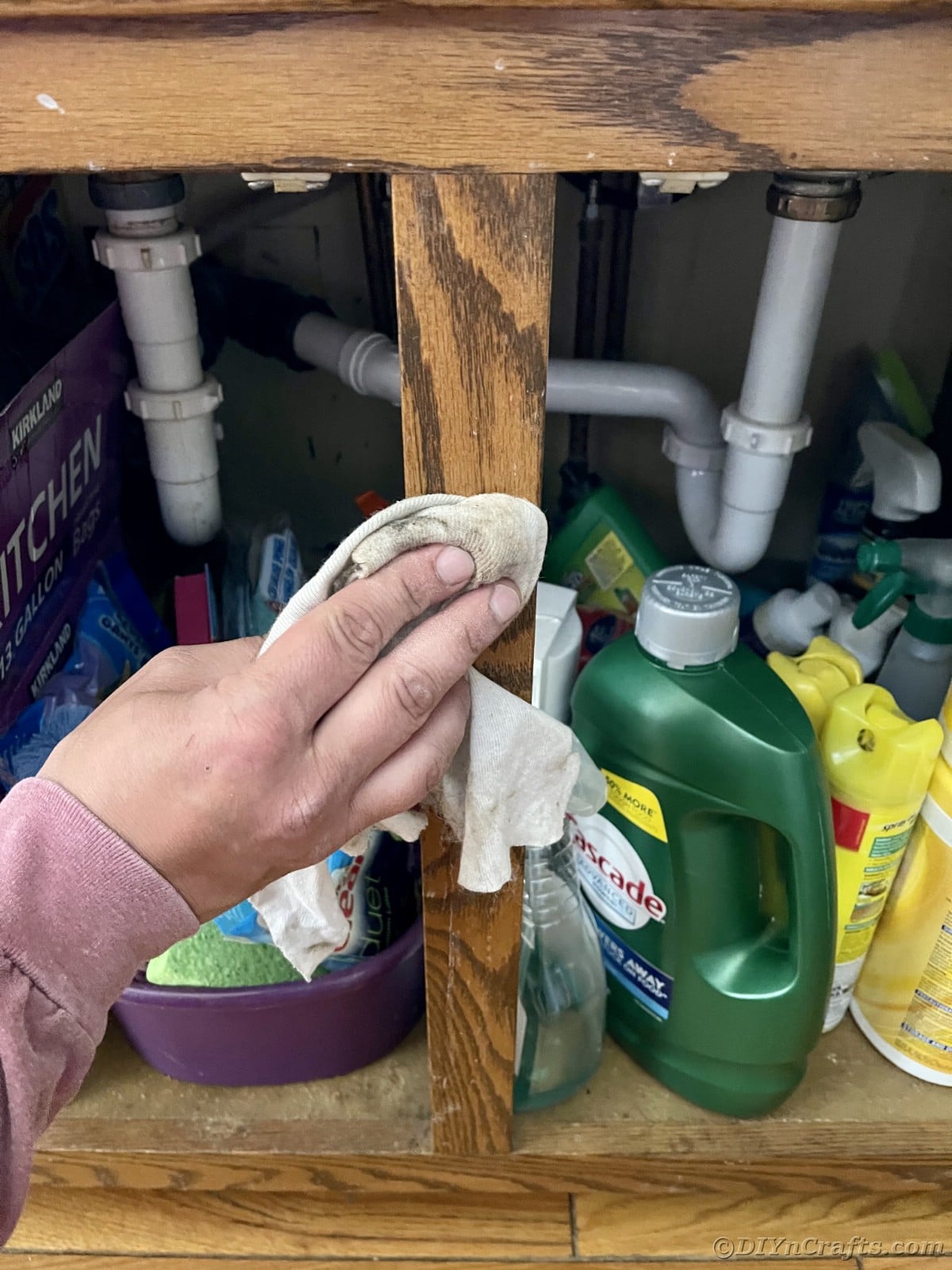
Once you are done cleaning everything it will be time to begin sanding your cabinet bases, floorboards, and trim. Using an orbital sander with 220 grit sandpaper for this process. Use a sanding block to get into any hard-to-reach areas.
Everything should be sanded to a smooth finish. Once you are done sanding, run your hand over the surfaces to make sure you didn’t miss anything.
Using a rag, remove any dust or debris left over from sanding. Make sure you wipe all cabinet bases inside and out of cabinets and countertops and then sweep the floors. Remove all debris will make sure you have a smooth finish with no particles in the paint.
Cleaning and Sanding Doors and Drawers
In your workspace, it’s now time to clean your doors and drawer fronts. Put on your mask again and prepare your mineral spirits and an old t-shirt or rag to begin cleaning.
Clean the cabinet doors and drawers like mentioned above for the bases in your kitchen. Be sure to clean both sides of the doors, not just the front. Also, be sure to clean any cracks or crevices. Elbow grease is important to make sure you remove all of the grease, food, cabinet protectors, and debris.
Using the orbital sander and 220 grit sandpaper, sand each door, front and back. Be sure to sand the edges of the door as well. Sand until everything is smooth, taking your time to ensure it is smooth, and use a sanding block to reach hard-to-reach places.
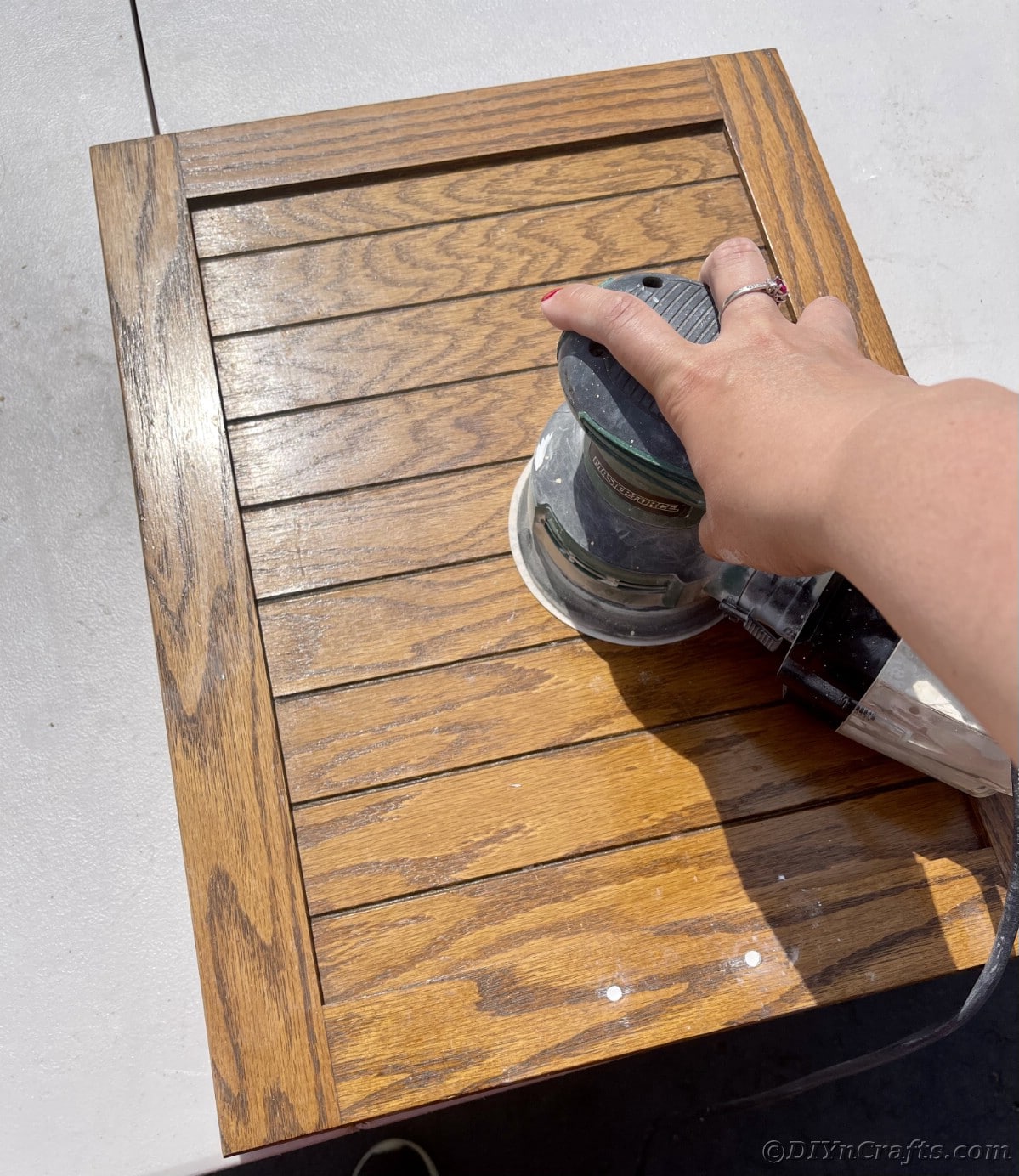
Once you are done sanding, you will want to grab another rag to wipe down all of the doors and drawers. Be sure there is no dust or debris leftover from sanding. It is ideal to sweep out the area or blow it out with a leaf blower if possible.
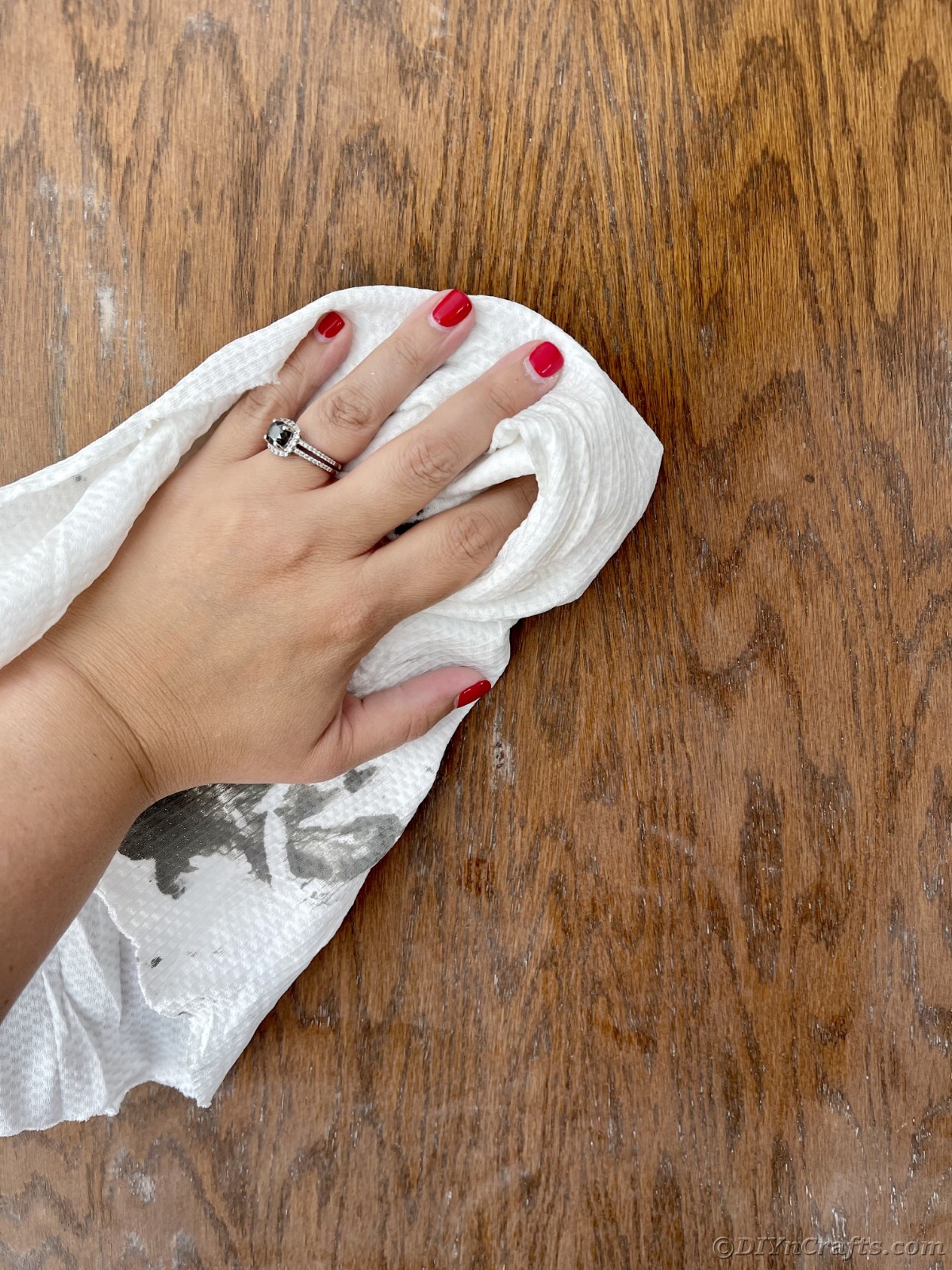
Place the cabinet doors and drawers where they will be able to dry once painted. Each cabinet should have a home that it carefully goes back to dry on the 2×4’s or an area where they will not be disturbed.
If needed, you can stack them like shown below.
How to Prime your Kitchen Cabinets Before Painting
Once ready, you will begin priming. Since the final paint color here is gray, using a gray primer worked well. Just make sure you don’t use a darker color than what the final paint color will be. Mix the primer thoroughly then pour into the paint tray and/or a handheld bucket.
Use your paintbrush to cut in along the walls, appliances, trim, ceiling, floorboards, and trim.
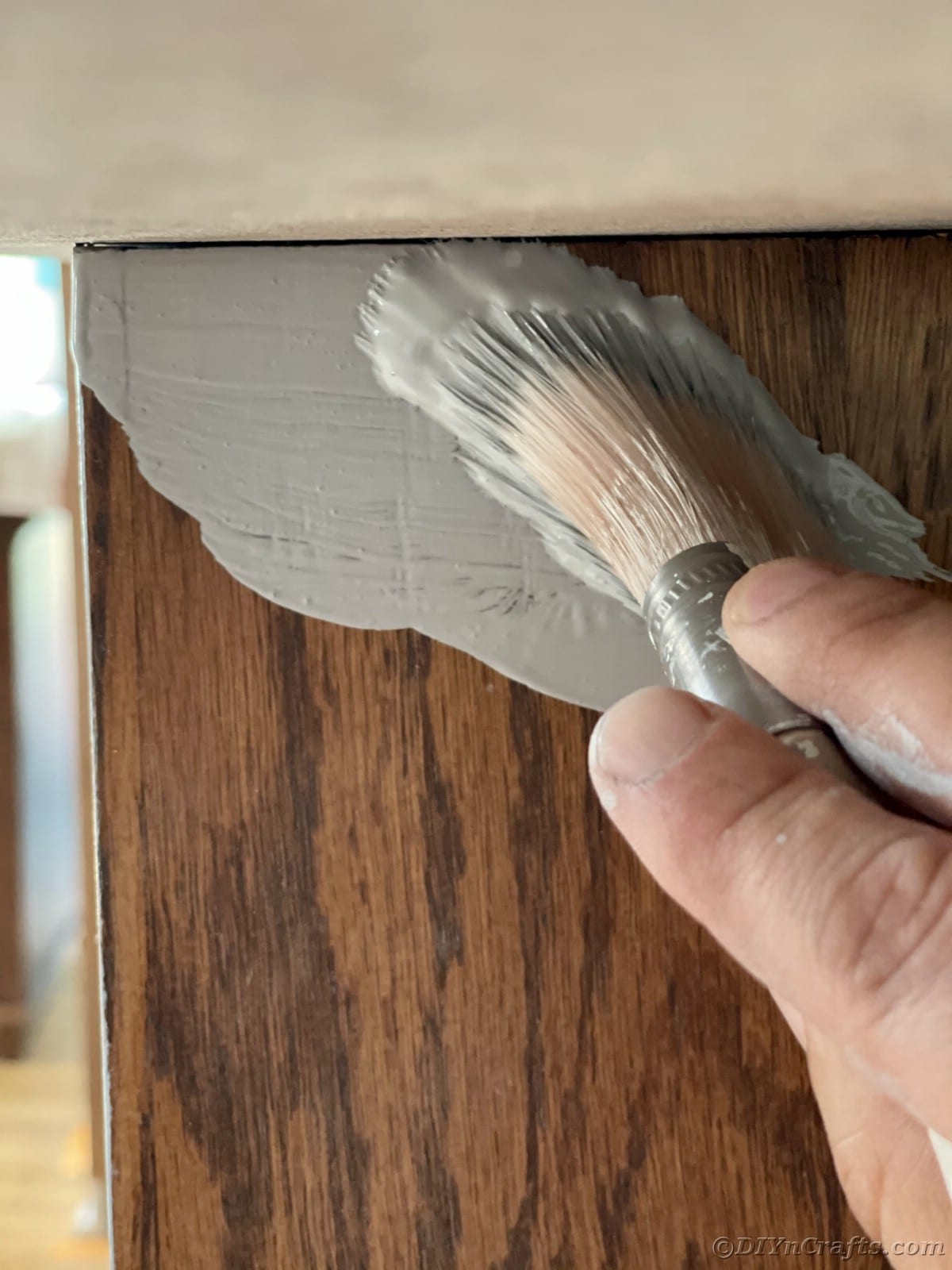
Be careful and use a steady hand to reach all of the areas. I like to use the tip of the brush to cut in around the edges and the 5-in1 tool if necessary.
All flat areas such as fronts of cabinet bases and sides of the cabinets can be painted using a roller in smooth long strokes. Just make sure you have adequate paint on the roller before application. Do not overdo the paint, but add an even coat. Check for any drips and touch up if needed.
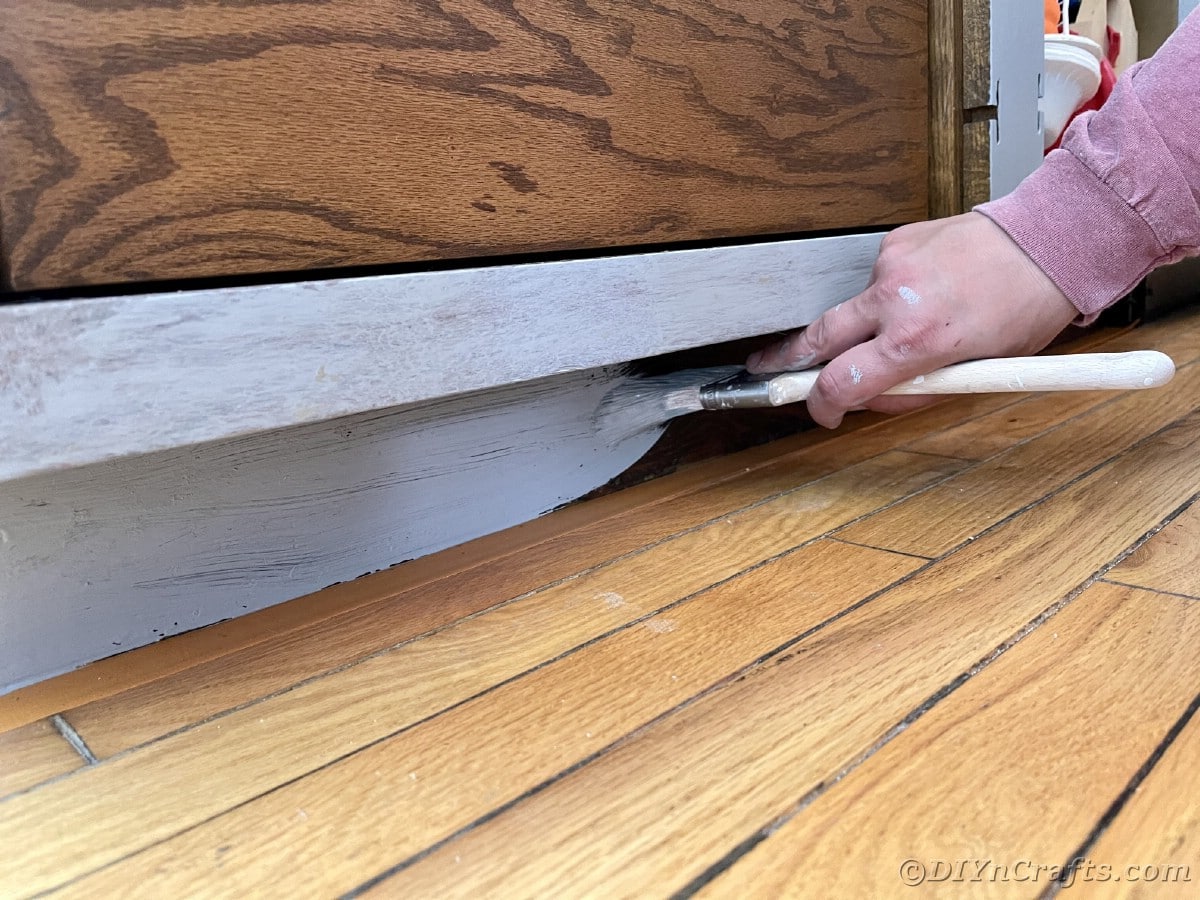
Be sure to paint the inside cabinet trim as well. Sometimes this will lay flat to the inside of the cabinet and sometimes there will be a slight lip. If there is a lip, you can easily use your roller without getting paint inside the cabinet. If there is no lip, you will need to apply this with a brush. Just make sure you add painter’s tape on the inside of the cabinet to ensure a clean line.
It is best to start at the top and work your way down so your ladder or body doesn’t brush up against your primed bases. Allow your kitchen to prime fully according to the primer directions. This can take up to 4 to 6 hours to dry completely.
How to Prime the Cabinet Doors Before Painting
Move to your workspace and prime the backs of the cabinet doors. Using a paint spray, fill the gun according to the manufacturer’s directions. Ideally use a large bucket so you can spray evenly with the appropriate suction. For this restoration project, a Graco TrueCoat 360 Spray gun was used.
Starting with the widest doors first, place the door with the back facing upwards or toward you. Hold the spray gun around 18″ away from the door and spray all four sides of the cabinet first from the top to bottom then cover the back of the cabinet.
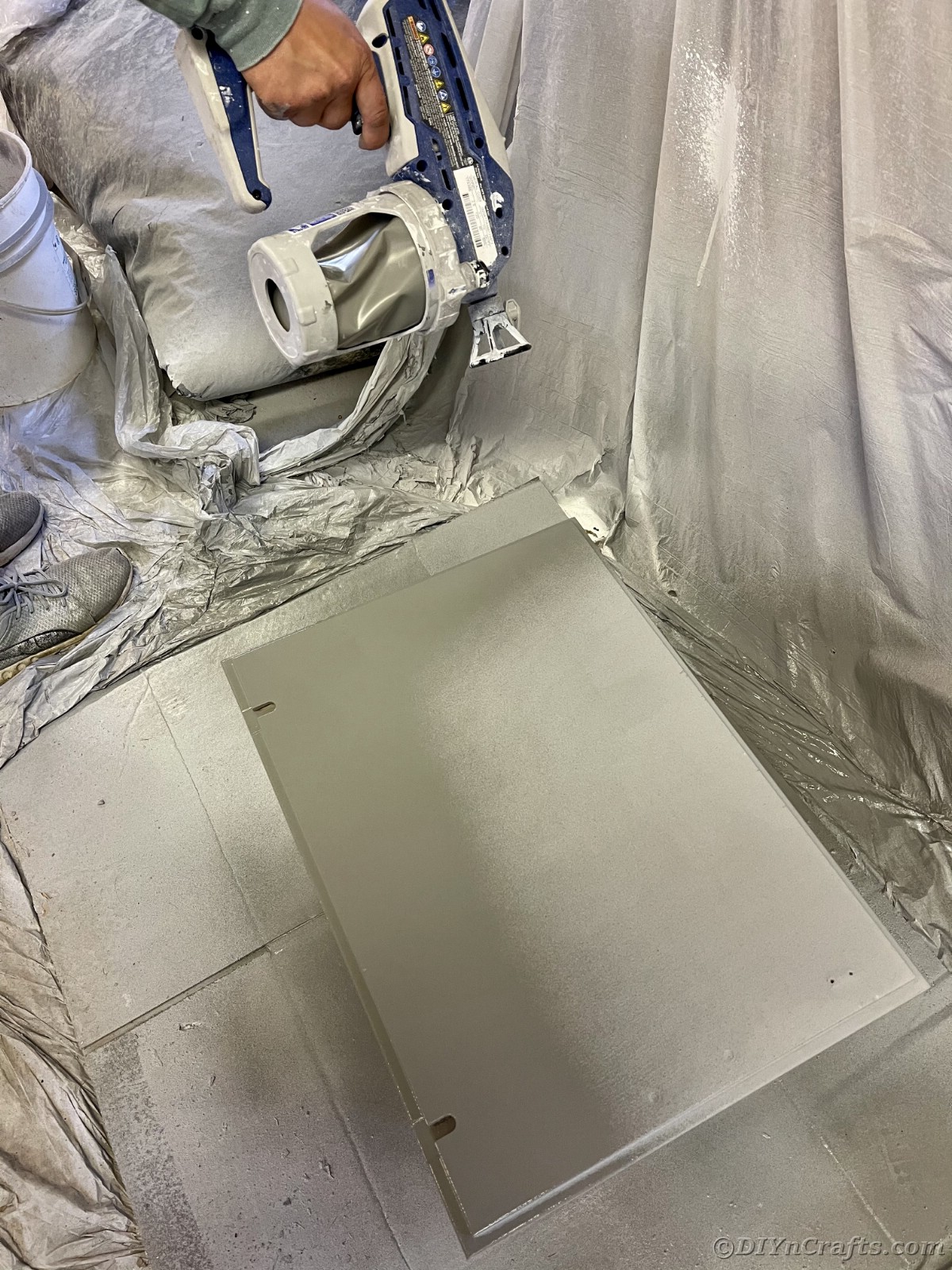
Try to only spray once on each section of the door. First horizontally on the top, then down the side, then horizontally across the bottom, then down the other side, then from top to bottom vertically to cover.
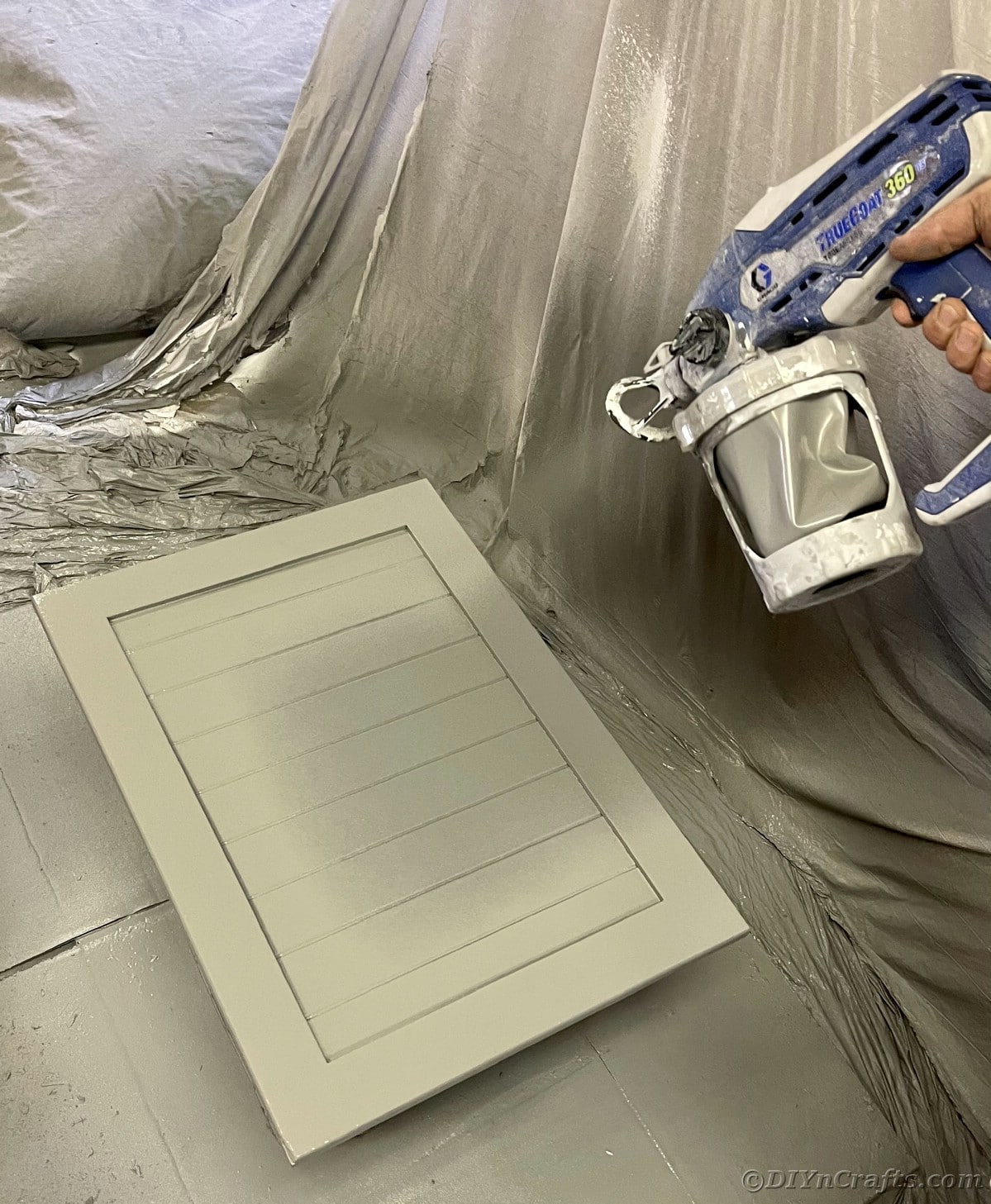
As you get to the smaller or skinnier doors, be sure to place the door on a crate where it is not touching wet paint. Start to edge the door off of the crate so you don’t get wet paint on the front of the cabinet. Place a new box or crate if necessary.
Once the back of the door is fully and evenly sprayed carefully, squat at your knees and pick up the door only placing your hands completely underneath the door and place it back to its drying area.
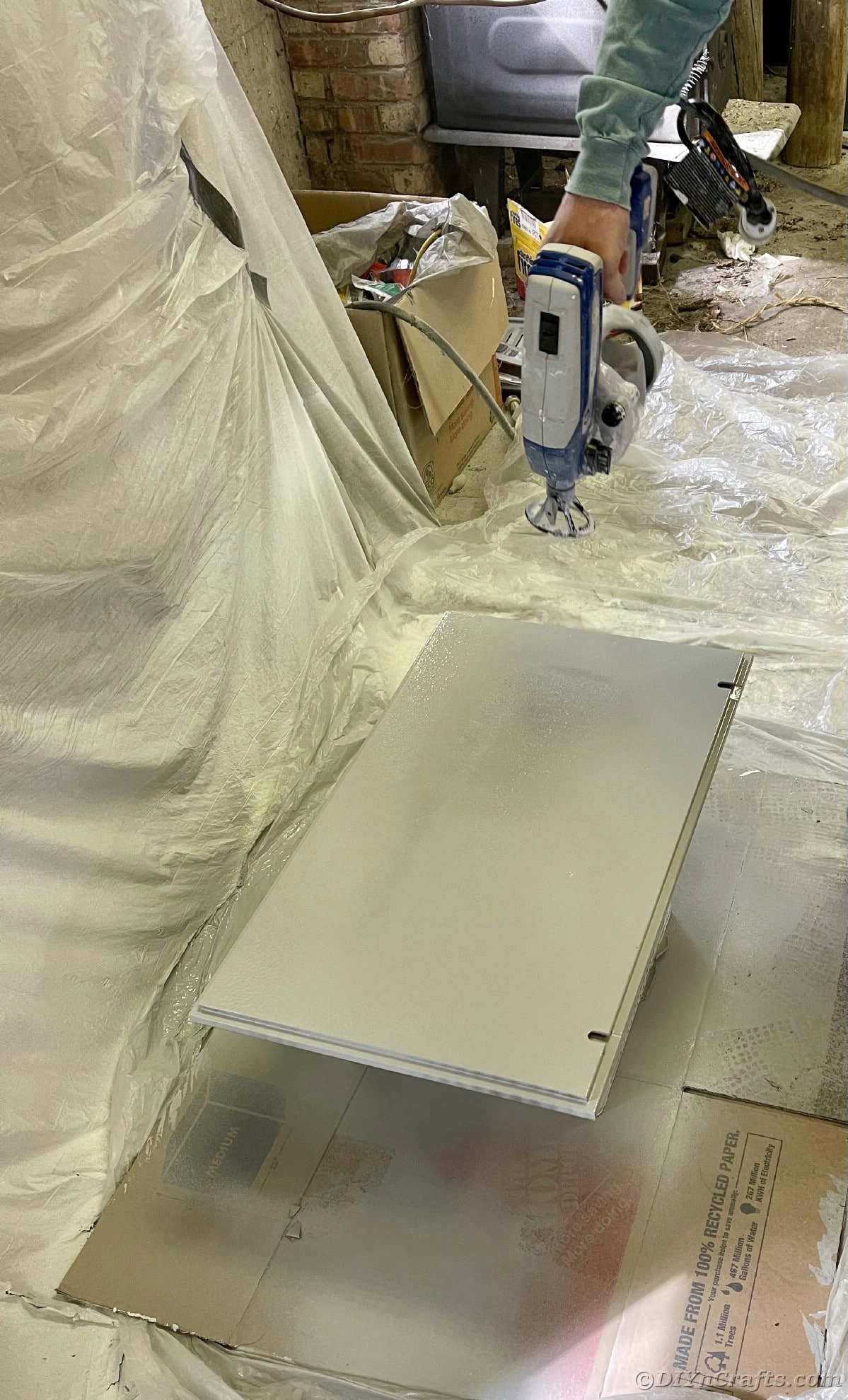
Continue this process until all of the backs of the cabinet doors are sprayed. If you needed to or were able to remove drawer faces, follow the same process with them as well.
If the drawer faces do not come off of the drawer, use a roller to coat them making sure to get the edges of the drawer face as well as the entire front. It is not necessary to paint the inside if they are attached to the drawer.
Allow all of the drawers and cabinet doors to dry completely according to the manufacturer’s directions. This usually takes 4 to 6 hours.
If you plan to prime the front of the doors and drawers on the same day, you can place the paint tray, rollers, and brush into an airtight bag until ready to use. If you are not going to use it again that day, make sure to clean out your spray gun well so it doesn’t develop a clog overnight.
When everything is dry, you will repeat the same process on the front of the doors.
Let the doors fully dry as directed by the primer manufacturer and clean everything thoroughly. Since you can reuse the paintbrushes, trays, buckets, and roller again, you want to make sure you wash and rinse well with warm water or a brush cleaner.
Primer will look a bit streaky. That is expected.
Sand Primed Surfaces
Once the primer is completely dried, it’s time to begin sanding. Use the 220 grit sanding block to lightly sand your cabinet bases, trim, and floorboards smooth. If you notice any paint drips or uneven paint, make sure to sand those smooth at this time.
You may also want to check for any debris, dust, or hair that could have gotten trapped in the paint and remove it as well. Anywhere you primed the cabinets you should lightly sand them to ensure they are smooth before painting. Repeat this on all doors and drawers.
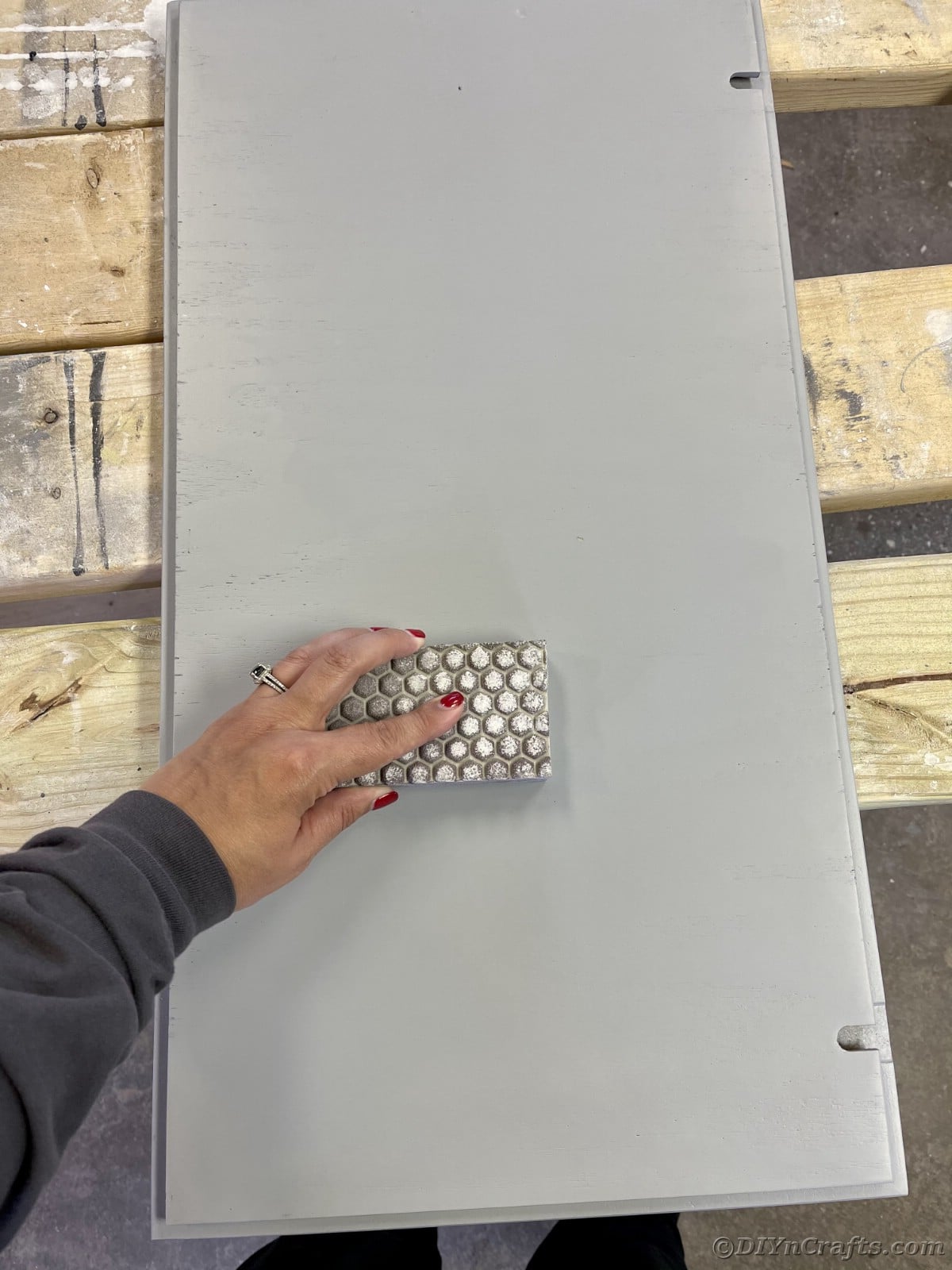
Do not use the orbital sander as it is too powerful for this process.
Use a soft cloth or t-shirt rag to remove all dust, debris, cabinets, cabinet faces, trim, floorboards, and drawers. Be sure to also sweep out the kitchen or workspace to keep things clean for the next step.
Applying the First Coat of Paint to the Cabinets
Once everything has been sanded, you should begin painting. The paint chosen for this is Benjamin Moore Advance Satin paint in Grizzle Gray. You get what you pay for with paint, so invest in a quality brand that will give you a durable and lasting finish.
Mix the paint thoroughly with a wooden stick and then pour the paint into a clean paint tray as well as a hand-held paint bucket.
Using your paintbrush, cut along the walls, appliances, trim, ceiling, floorboards, and trim. Be careful and get all hard-to-reach areas with the brush tip. On the front of the cabinet bases, use a roller in smooth long strokes.Make sure the entire area is covered in a nice even layer watching for drips before moving to the next area.
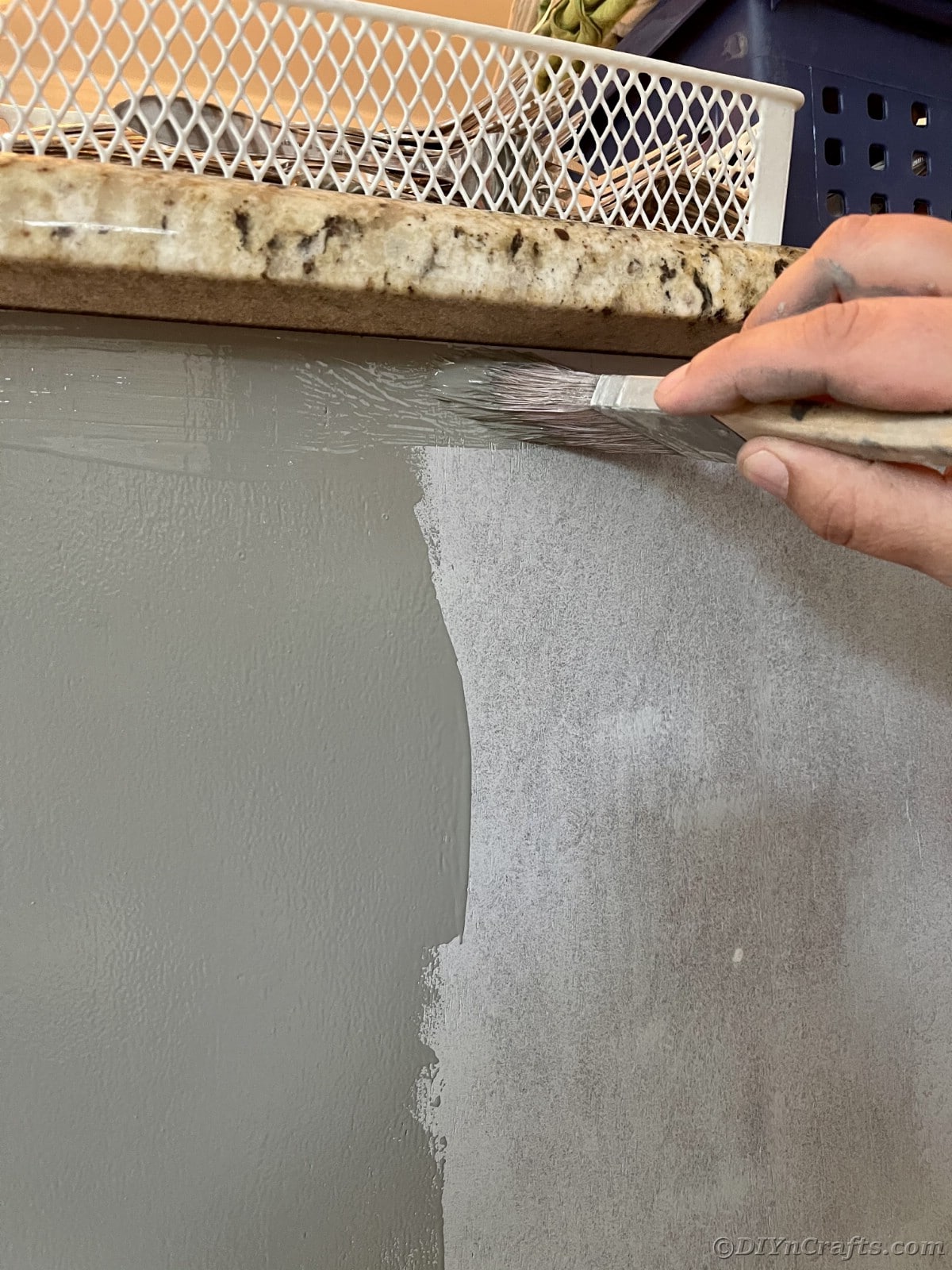
Make sure to paint the inside cabinet trim as well. Use a roller or brush depending upon the lip on the cabinets. Use painter’s tape like when first priming the cabinets to cover items as needed to prevent drips or getting paint where you don’t want it to be.
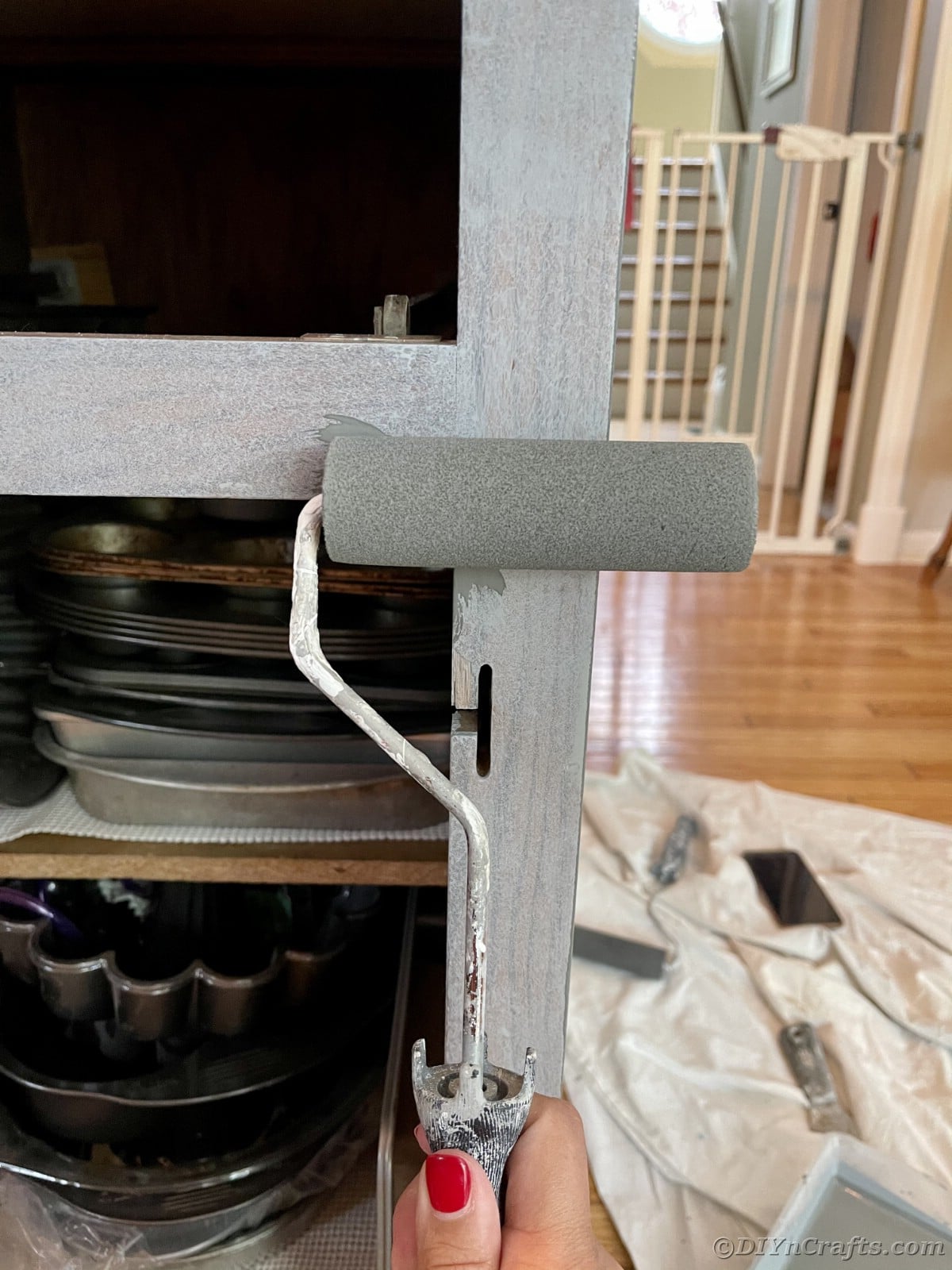
Let the first coat of paint dry completely according to the manufacturer’s directions. This can take up to 24-hours, so make plans for it to dry overnight before you begin applying the second coat of paint.
Applying the First Coat of Paint to Doors and Drawers
Following the same process you did with priming the doors, apply a coat of paint to the doors and drawers. Be careful to follow the steps making sure you get in all hard-to-reach places as well as watching for drips.
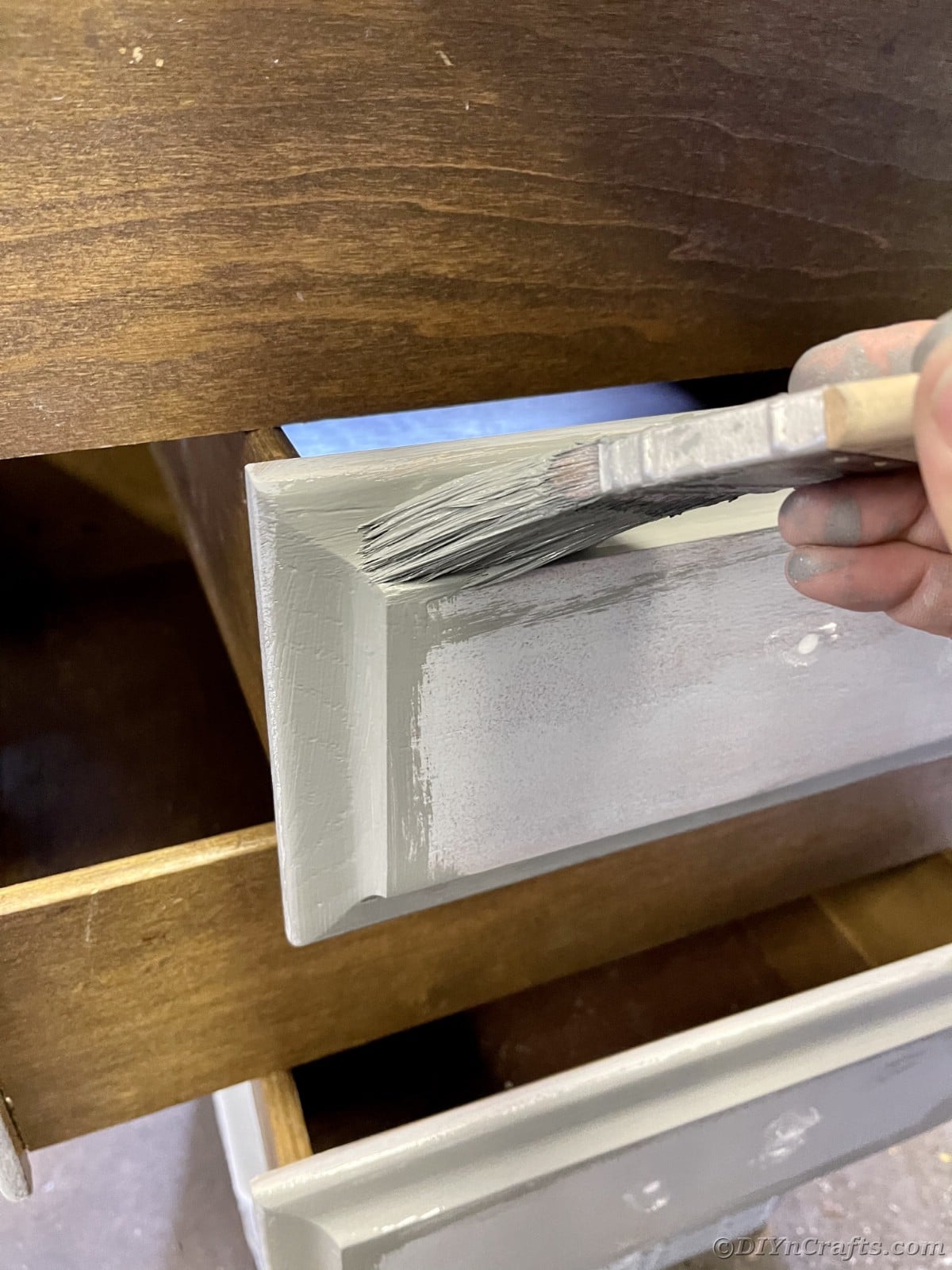
Set them aside to dry for at least 24 hours or as long as the manufacturer suggests before applying a second coat.
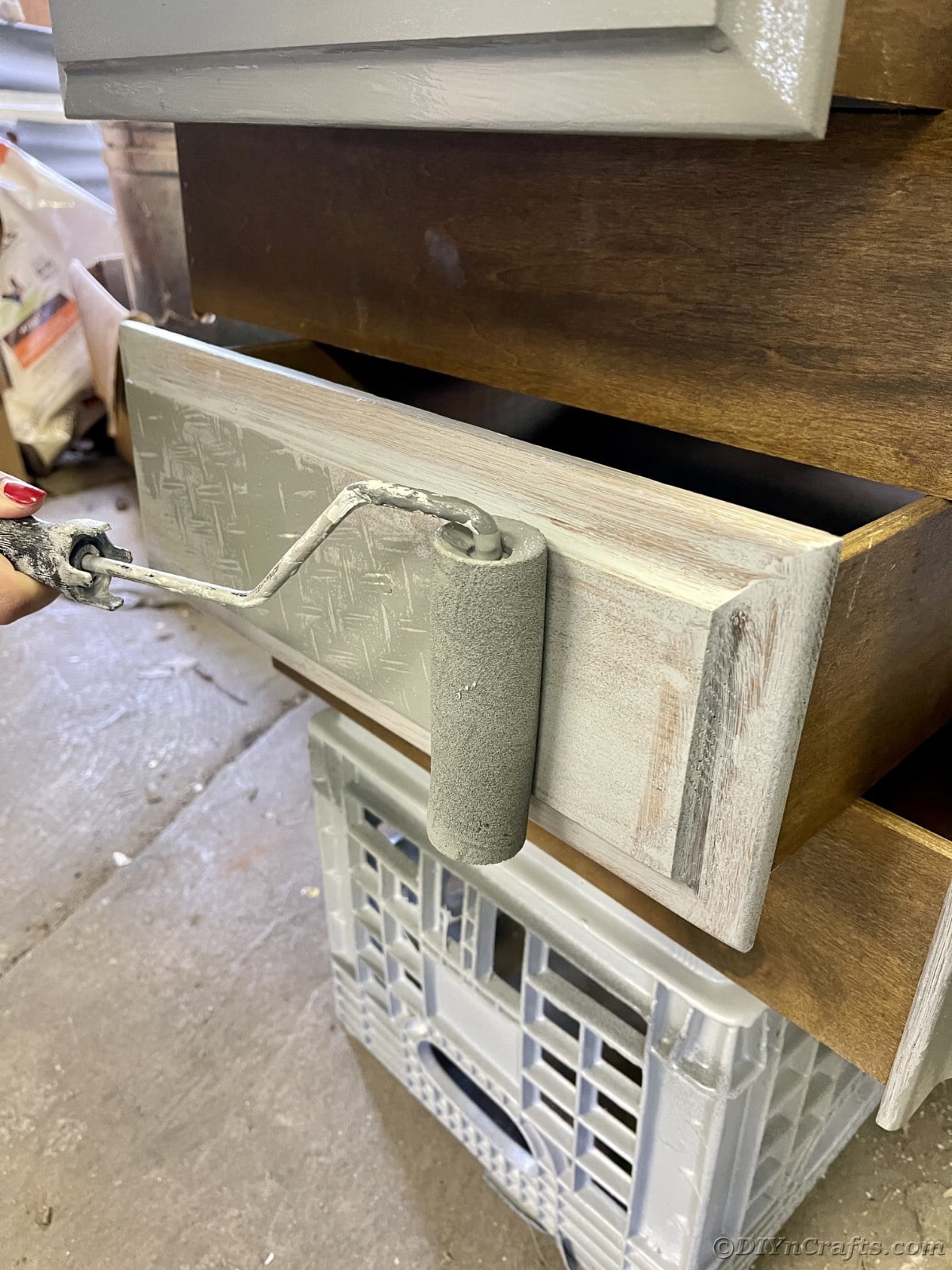
Place your roller, paintbrush, paint tray, and paint can into an airtight bag and clean up your spray gun so it doesn’t create clumps. Set them aside until time for your second coat of paint.
Sanding Cabinet Bases and Trim
Once the first coat of paint has dried completely you will begin sanding again. Use a 220 sanding block to lightly sand any built-up drips of paint. Get rid of any debris or dust and sand as needed.
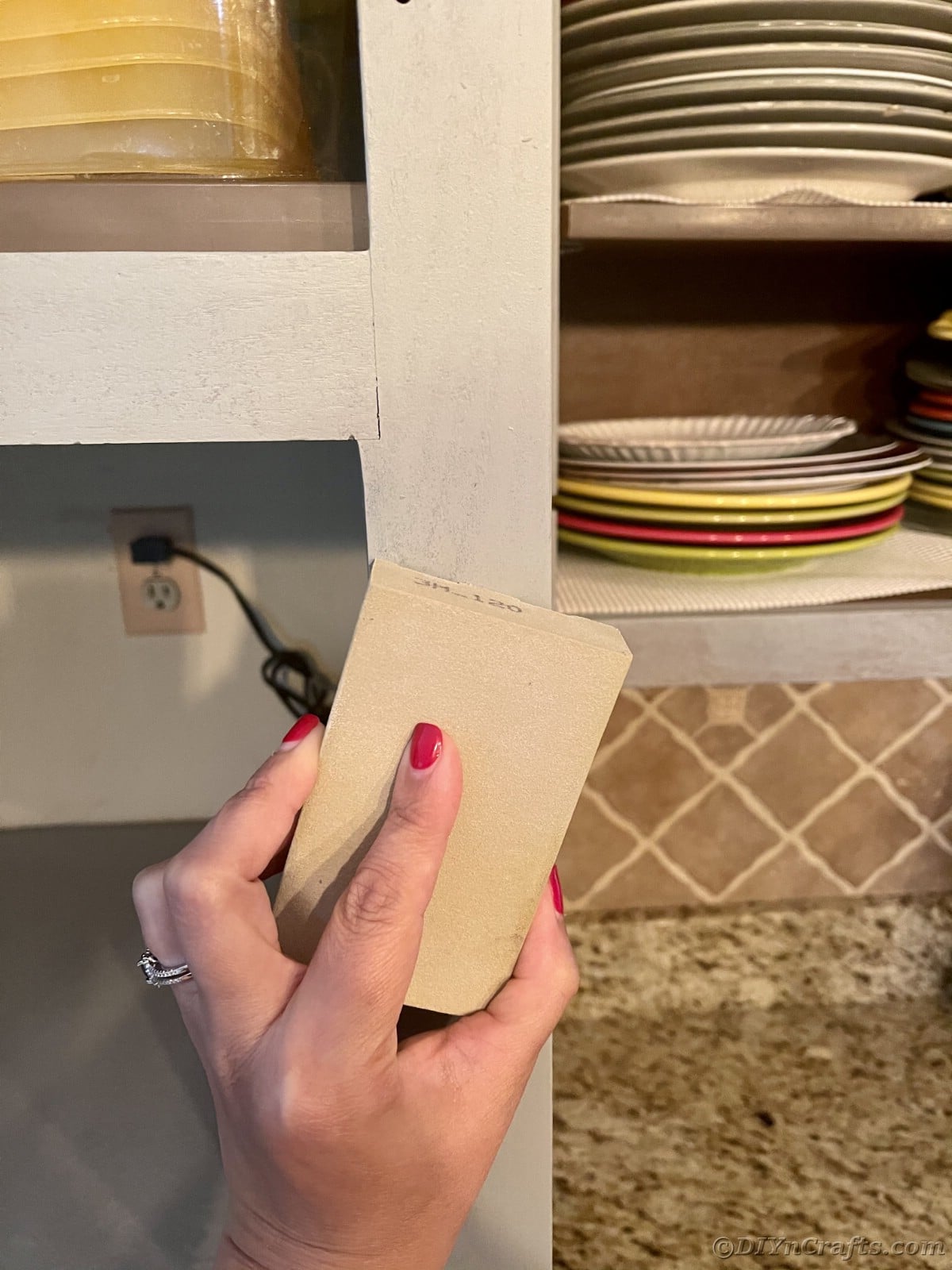
Once all cabinet bases, trim, floorboards, drawers, and cabinet doors have all been sanded, wipe them down with a rag or t-shirt removing any additional dirt, dust, or debris.
Applying Second Coat of Paint
After sanding and cleaning everything, begin applying the second coat of paint. You will follow the same process as mentioned above for the first coat.
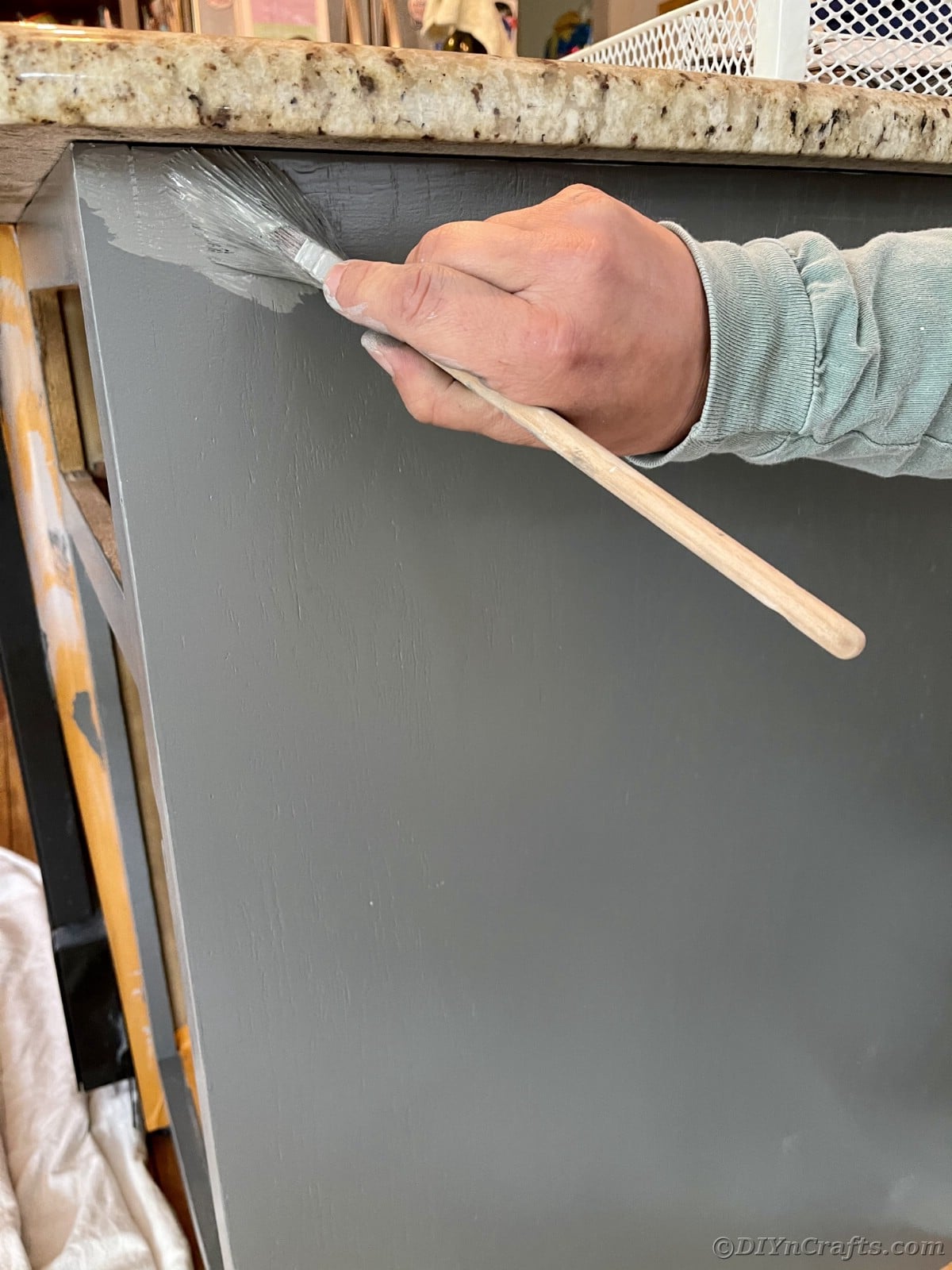
Once everything has been pained with a second coat of paint, let them dry for 24 to 48 hours. Clean up all of your tools including paint brushes, paint trays, rollers, and spray gun, and put away for your next project.
Let the pieces dry completely so that there is no sticky paint or tacky areas left on the cabinet doors or drawers.
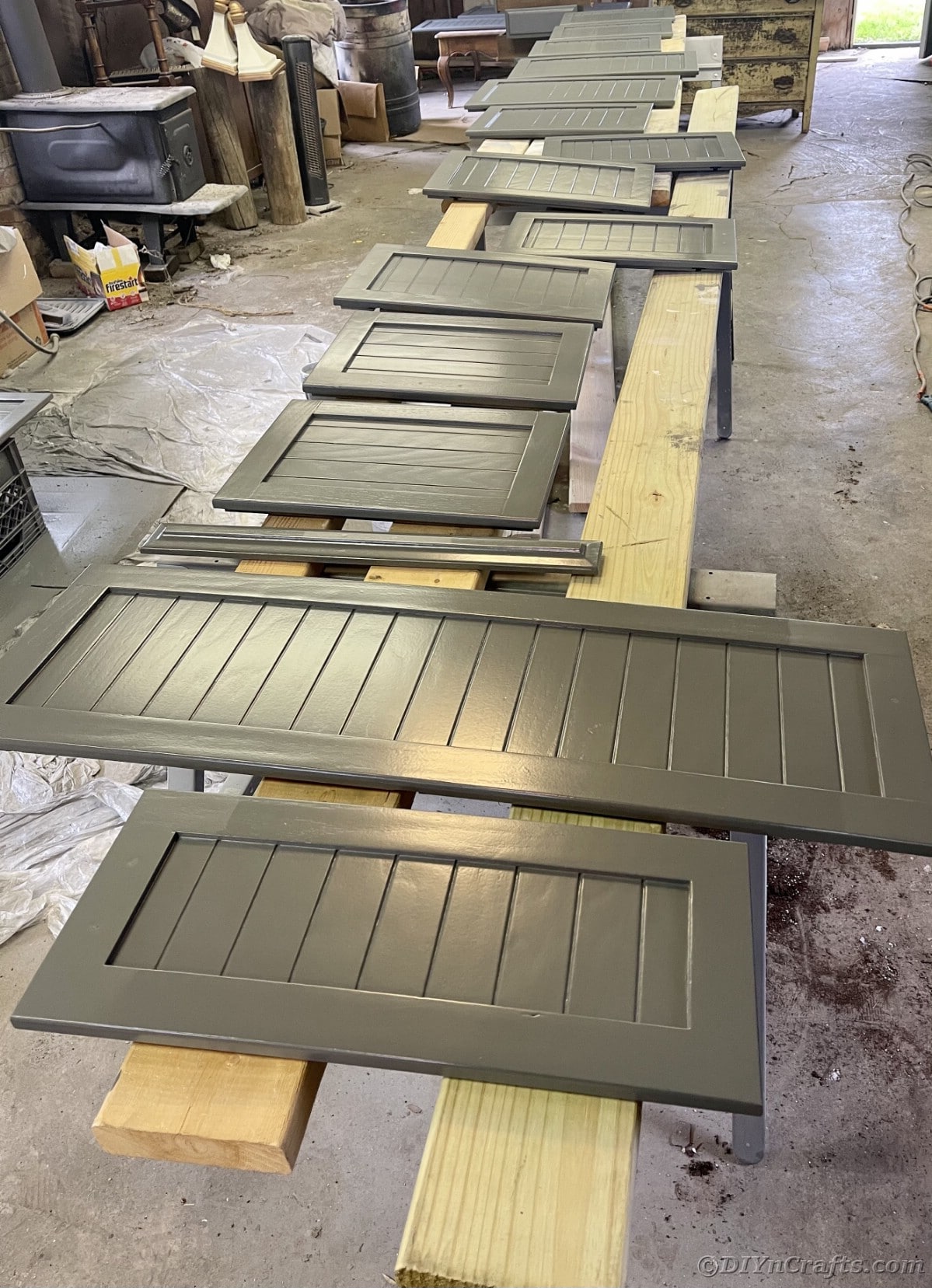
If your pieces need a third coat, repeat the same process again then let dry before hanging back into place.
Hanging the Doors and Drawers Back onto Kitchen Cabinets
Refer back to the notes you took when removing all of your hardware, doors, and drawers. Check the measurements and placement, and set up your area to assemble and put back into place.
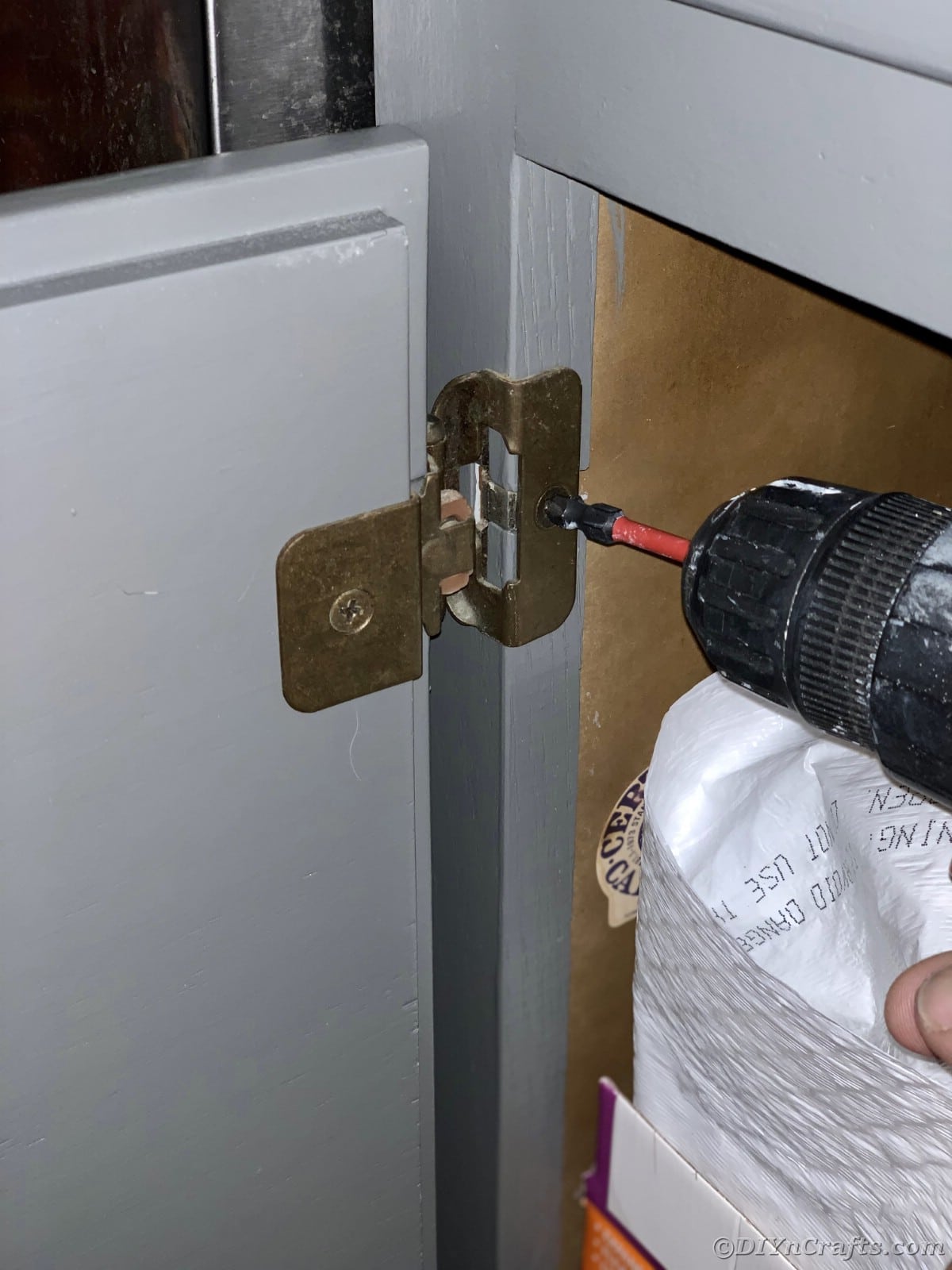
Be careful as you move and attach things. While the paint may be dry, it is still soft and needs a full 30-days to harden.
Reattach your hardware and doors, then drawers until everything is back in place. Adjust things as needed and be very careful for at least 30-days to make sure you allow the paint to cure properly.
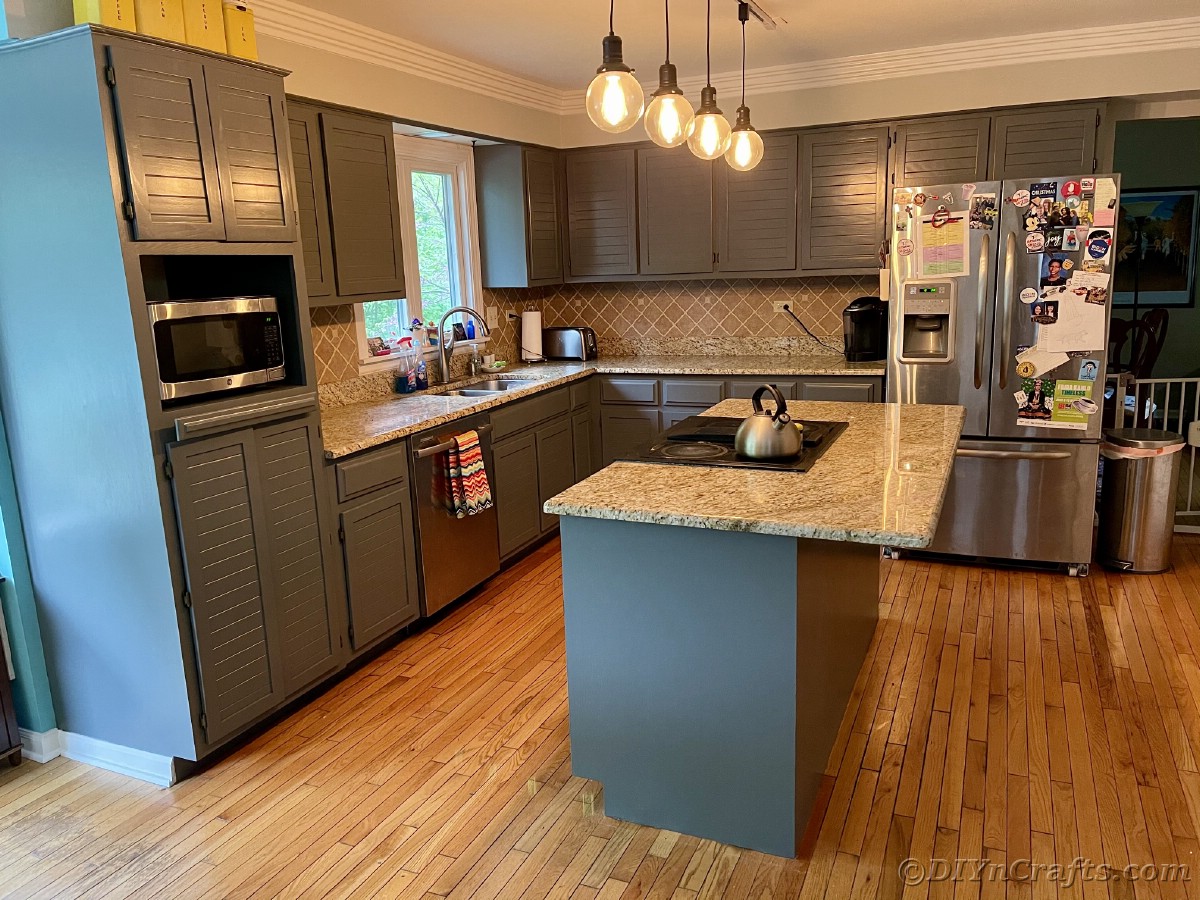
How to Manage Touch Ups
Sometimes you will find a little knick in the paint on your doors or drawers. You can easily use a dab of paint to fill in those areas as necessary then hang again once completely dry.
After the full 30-days curing time, you can then wipe down your cabinets with a soft damp cloth or Magic Eraser as needed.
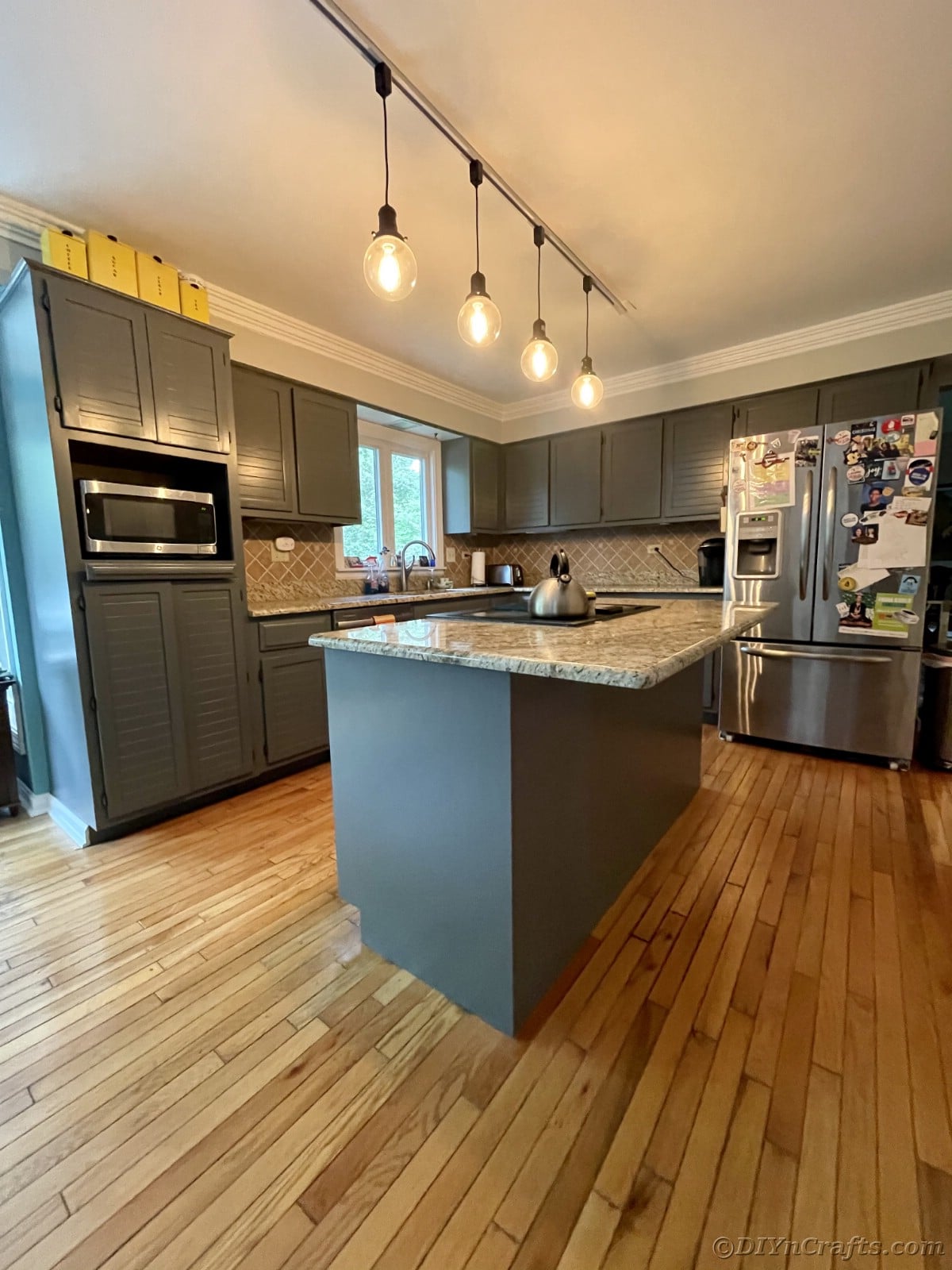
Yield: 1
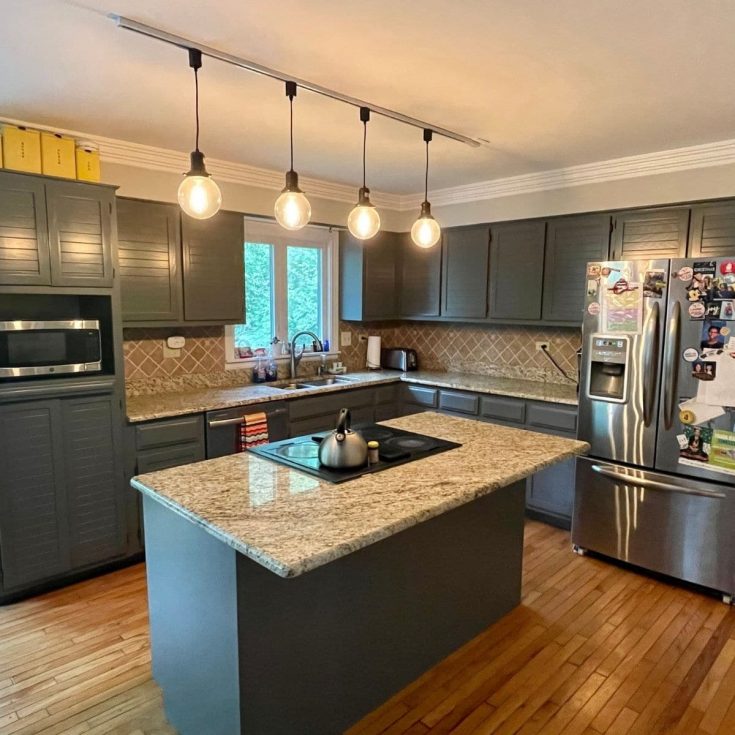
Follow a step by step tutorial for an amazing kitchen cabinet renovation that is a perfect way to update an out of style look!
Prep Time
30 minutes
Active Time
5 hours
Additional Time
5 days
Total Time
5 days 5 hours 30 minutes
Difficulty
Medium
Estimated Cost
$100
Instructions
How to Set Up Your Work Space
- Set up a large area to not just paint, but allow your pieces to dry properly before you hang them. I recommend a garage or shop where you can lay everything out and shut it away so nothing gets on it before it dries. It’s important to plan ahead so it won’t have a lot of people walking around or the potential for it to be damaged before it dries.
- Sweep out the area you are using and pick up anything that may be on the floors or could cause dust or debris to fall onto your freshly painted items.
- Place drop cloths or plastic on the floors and walls to protect the space from any paint drips or spray. Painters tape or duct tape can be used to secure it. This is good for keeping the walls and floor from being painted accidentally by overspray.
- Place crates or boxes in the center of your spraying area. This will be used when you spray your cabinet doors and drawers. I recommend either making sure you have something set up so you aren’t worried about it being damaged or painted over. It needs to be sturdy enough to hold the pieces and not topple over.
- Set up your saw horses and 2×4 boards so that the pieces can lay flat while drying. It works best with one sawhorse on each end and one in the middle. Just make sure you have enough room for every piece to dry whether on the 2×4 or on a box or the ground with plastic underneath.
- Cover your kitchen countertops, floors, and appliances with drop cloths or flat sheets to protect them from any dripping paint. Frogger Painters Tape is best for holding these things in place without damaging them when removed. You may also want to use this over any parts of the cabinets you don’t want to be painted.
Removing the Kitchen Drawers and Doors
- Measure, mark, or take note of each of the cabinet doors and drawers so you know where they will go back after being painted. A diagram and numbering them is helpful.
- Use a power drill to remove all of the cabinet doors. Be careful to remove all hinges and make sure you take notes of how to assemble them again. Taking pictures, making a diagram, or marking these is important to make sure everything goes back exactly where it came from. Place the hinges and hardware into the cabinet itself to keep it handy for hanging later.
- Remove all drawers completely being careful to make note of where they go in the cabinetry. Remove any hardware and place it back into the drawer it belongs to for safekeeping. Take the doors and drawers to the area you have designated for working.
Cleaning and Sanding Cabinets
- Prepare yourself by adding a face mask or respirator, and gathering your rags and mineral spirits. If possible, you will also want to open windows for ventilation while using mineral spirits.
- Begin working top to bottom, and wipe down all cabinet bases, floorboards, and trim around the kitchen. Use the mineral spirits as needed and remove all grease, food, or debris. You will also want to remove any stickers or glue on the cabinets using a scraper tool. Mineral spirits also work well on unwanted sticky residue.
- Go over everything twice to make sure you are getting all of the little bits of dust and grim.
- Once you are done cleaning everything it will be time to begin sanding your cabinet bases, floorboards, and trim. Using an orbital sander with 220 grit sandpaper for this process. Use a sanding block to get into any hard to reach areas.
- Everything should be sanded to a smooth finish. Once you are done sanding, run your hand over the surfaces to make sure you didn’t miss anything.
- Using a rag, remove any dust or debris left over from sanding. Make sure you wipe all cabinet bases inside and out of cabinets and countertops and then sweep the floors. Remove all debris will make sure you have a smooth finish with no particles in the paint.
Cleaning and Sanding Doors and Drawers
- In your workspace, it’s now time to clean your doors and drawer fronts. Put on your mask again and prepare your mineral spirits and an old t-shirt or rag to begin cleaning.
- Clean the cabinet doors and drawers like mentioned above for the bases in your kitchen. Be sure to clean both sides of the doors, not just the front. Also, be sure to clean any cracks or crevices. Elbow grease is important to make sure you remove all of the grease, food, cabinet protectors, and debris.
- Using the orbital sander and 220 grit sandpaper, sand each door, front and back. Be sure to sand the edges of the door as well. Sand until everything is smooth, taking your time to ensure it is smooth, and use a sanding block to reach hard-to-reach places.
- Once you are done sanding, you will want to grab another rag to wipe down all of the doors and drawers. Be sure there is no dust or debris leftover from sanding. It is ideal to sweep out the area or blow it out with a leaf blower if possible.
- Place the cabinet doors and drawers where they will be able to dry once painted. Each cabinet should have a home that it carefully goes back to dry on the 2×4’s or an area where they will not be disturbed.
- If needed, you can stack them like shown below.
How to Prime your Kitchen Cabinets Before Painting
- Once ready, you will begin priming. Since the final paint color here is gray, using a gray primer worked well. Just make sure you don’t use a darker color than what the final paint color will be. Mix the primer thoroughly then pour into the paint tray and/or a handheld bucket.
- Use your paintbrush to cut in along the walls, appliances, trim, ceiling, floorboards, and trim. Be careful and use a steady hand to reach all of the areas. I like to use the tip of the brush to cut in around the edges and the 5-in1 tool if necessary.
- All flat areas such as fronts of cabinet bases and sides of the cabinets can be painted using a roller in smooth long strokes. Just make sure you have adequate paint on the roller before application. Do not overdo the paint, but add an even coat. Check for any drips and touch up if needed.
- Be sure to paint the inside cabinet trim as well. Sometimes this will lay flat to the inside of the cabinet and sometimes there will be a slight lip. If there is a lip, you can easily use your roller without getting paint inside the cabinet. If there is no lip, you will need to apply this with a brush. Just make sure you add painter’s tape on the inside of the cabinet to ensure a clean line.
- It is best to start at the top and work your way down so your ladder or body doesn’t brush up against your primed bases. Allow your kitchen to prime fully according to the primer directions. This can take up to 4 to 6 hours to dry completely.
How to Prime the Cabinet Doors Before Painting
- Move to your workspace and prime the backs of the cabinet doors. Using a paint spray, fill the gun according to the manufacturer’s directions. Ideally use a large bucket so you can spray evenly with the appropriate suction. For this restoration project, a Graco TrueCoat 360 Spray gun was used.
- Starting with the widest doors first, place the door with the back facing upwards or toward you. Hold the spray gun around 18″ away from the door and spray all four sides of the cabinet first from the top to bottom then cover the back of the cabinet. Try to only spray once on each section of the door. First horizontally on the top, then down the side, then horizontally across the bottom, then down the other side, then from top to bottom vertically to cover.
- As you get to the smaller or skinnier doors, be sure to place the door on a crate where it is not touching wet paint. Start to edge the door off of the crate so you don’t get wet paint on the front of the cabinet. Place a new box or crate if necessary.
- Once the back of the door is fully and evenly sprayed carefully, squat at your knees and pick up the door only placing your hands completely underneath the door and place it back to its drying area.
- Continue this process until all of the backs of the cabinet doors are sprayed. If you needed to or were able to remove drawer faces, follow the same process with them as well.
- If the drawer faces do not come off of the drawer, use a roller to coat them making sure to get the edges of the drawer face as well as the entire front. It is not necessary to paint the inside if they are attached to the drawer.
- Allow all of the drawers and cabinet doors to dry completely according to the manufacturer’s directions. This usually takes 4 to 6 hours.
- If you plan to prime the front of the doors and drawers on the same day, you can place the paint tray, rollers, and brush into an airtight bag until ready to use. If you are not going to use it again that day, make sure to clean out your spray gun well so it doesn’t develop a clog overnight.
- When everything is dry, you will repeat the same process on the front of the doors.
- Let the doors fully dry as directed by the primer manufacturer and clean everything thoroughly. Since you can reuse the paintbrushes, trays, buckets, and roller again, you want to make sure you wash and rinse well with warm water or a brush cleaner.
- Primer will look a bit streaky. That is expected.
Sand Primed Surfaces
- Once the primer is completely dried, it’s time to begin sanding. Use the 220 grit sanding block to lightly sand your cabinet bases, trim, and floorboards smooth. If you notice any paint drips or uneven paint, make sure to sand those smooth at this time.
- You may also want to check for any debris, dust, or hair that could have gotten trapped in the paint and remove it as well. Anywhere you primed the cabinets you should lightly sand them to ensure they are smooth before painting. Repeat this on all doors and drawers.
- Do not use the orbital sander as it is too powerful for this process.
- Use a soft cloth or t-shirt rag to remove all dust, debris, cabinets, cabinet faces, trim, floorboards, and drawers. Be sure to also sweep out the kitchen or workspace to keep things clean for the next step.
Applying the First Coat of Paint to the Cabinets
- Once everything has been sanded, you should begin painting. The paint chosen for this is Benjamin Moore Advance Satin paint in Grizzle Gray. You get what you pay for with paint, so invest in a quality brand that will give you a durable and lasting finish.
- Mix the paint thoroughly with a wooden stick and then pour the paint into a clean paint tray as well as a hand-held paint bucket.
- Using your paintbrush, cut along the walls, appliances, trim, ceiling, floorboards, and trim. Be careful and get all hard-to-reach areas with the brush tip. On the front of the cabinet bases, use a roller in smooth long strokes. Make sure the entire area is covered in a nice even layer watching for drips before moving to the next area.
- Make sure to paint the inside cabinet trim as well. Use a roller or brush depending upon the lip on the cabinets. Use painter’s tape like when first priming the cabinets to cover items as needed to prevent drips or getting paint where you don’t want it to be.
- Let the first coat of paint dry completely according to the manufacturer’s directions. This can take up to 24-hours, so make plans for it to dry overnight before you begin applying the second coat of paint.
Applying the First Coat of Paint to Doors and Drawers
- Following the same process you did with priming the doors, apply a coat of paint to the doors and drawers. Be careful to follow the steps making sure you get in all hard-to-reach places as well as watching for drips.
- Set them aside to dry for at least 24 hours or as long as the manufacturer suggests before applying a second coat.
- Place your roller, paintbrush, paint tray, and paint can into an airtight bag and clean up your spray gun so it doesn’t create clumps. Set them aside until time for your second coat of paint.
Sanding Cabinet Bases and Trim
- Once the first coat of paint has dried completely you will begin sanding again. Use a 220 sanding block to lightly sand any built-up drips of paint. Get rid of any debris or dust and sand as needed.
- Once all cabinet bases, trim, floorboards, drawers, and cabinet doors have all been sanded, wipe them down with a rag or t-shirt removing any additional dirt, dust, or debris.
Applying Second Coat of Paint
- After sanding and cleaning everything, begin applying the second coat of paint. You will follow the same process as mentioned above for the first coat.
- Once everything has been pained with a second coat of paint, let them dry for 24 to 48 hours. Clean up all of your tools including paint brushes, paint trays, rollers, and spray gun, and put away for your next project.
- Let the pieces dry completely so that there is no sticky paint or tacky areas left on the cabinet doors or drawers.
- If your pieces need a third coat, repeat the same process again then let dry before hanging back into place.
Hanging the Doors and Drawers Back onto Kitchen Cabinets
- Refer back to the notes you took when removing all of your hardware, doors, and drawers. Check the measurements and placement, and set up your area to assemble and put back into place.
- Be careful as you move and attach things. While the paint may be dry, it is still soft and needs a full 30-days to harden.
- Reattach your hardware and doors, then drawers until everything is back in place. Adjust things as needed and be very careful for at least 30-days to make sure you allow the paint to cure properly.
How to Manage Touch Ups
- Sometimes you will find a little knick in the paint on your doors or drawers. You can easily use a dab of paint to fill in those areas as necessary then hang again once completely dry.
- After the full 30-days curing time, you can then wipe down your cabinets with a soft damp cloth or Magic Eraser as needed.
Notes
Tips Before You Begin
Before you begin making the changes to your kitchen, you will have some prep work to do. Below are some tips to consider before you begin tackling what will be a sizable project.
- Set aside a few days when you won’t need to have your kitchen fully functional. While it will mostly be work on the cabinet doors and drawers, you will need to let things dry completely.
- Create a marking system for each drawer and cabinet door before you remove them. Assembling everything after the paint has dried may be difficult if you don’t have the right items going back into the right places. Photographs or small marks on the interior with a pencil can work great.
There are some others that are important for the actual work, not just before you begin. Keep these things in mind so you have the best possible result.
- When cleaning the cabinets, doors, baseboards, drawers, and anything to be painted, be detailed and make sure all grease and dust are removed. Grease can get into strange places in the kitchen, so pay attention closely.
- When sanding the items before you prime them you will want to use elbow grease. Really get into it to get the best smooth finish to ensure the paint lays as smooth as possible. Be sure to also remove stickers or cabinet protectors and fill in any cracks, dents, or hardware holes with wood caulk before priming.
- Make sure you follow the paint manufacturer’s directions in regards to drying time. It may take up to 7 days for everything to dry completely and be hung in place again.
- While you may be able to hang the cabinets back in place once the paint has dried, but you do need to allow it to cure for 30-days before using any cleaning solution on the painted surfaces.
Use the colors you prefer to make your kitchen pop.
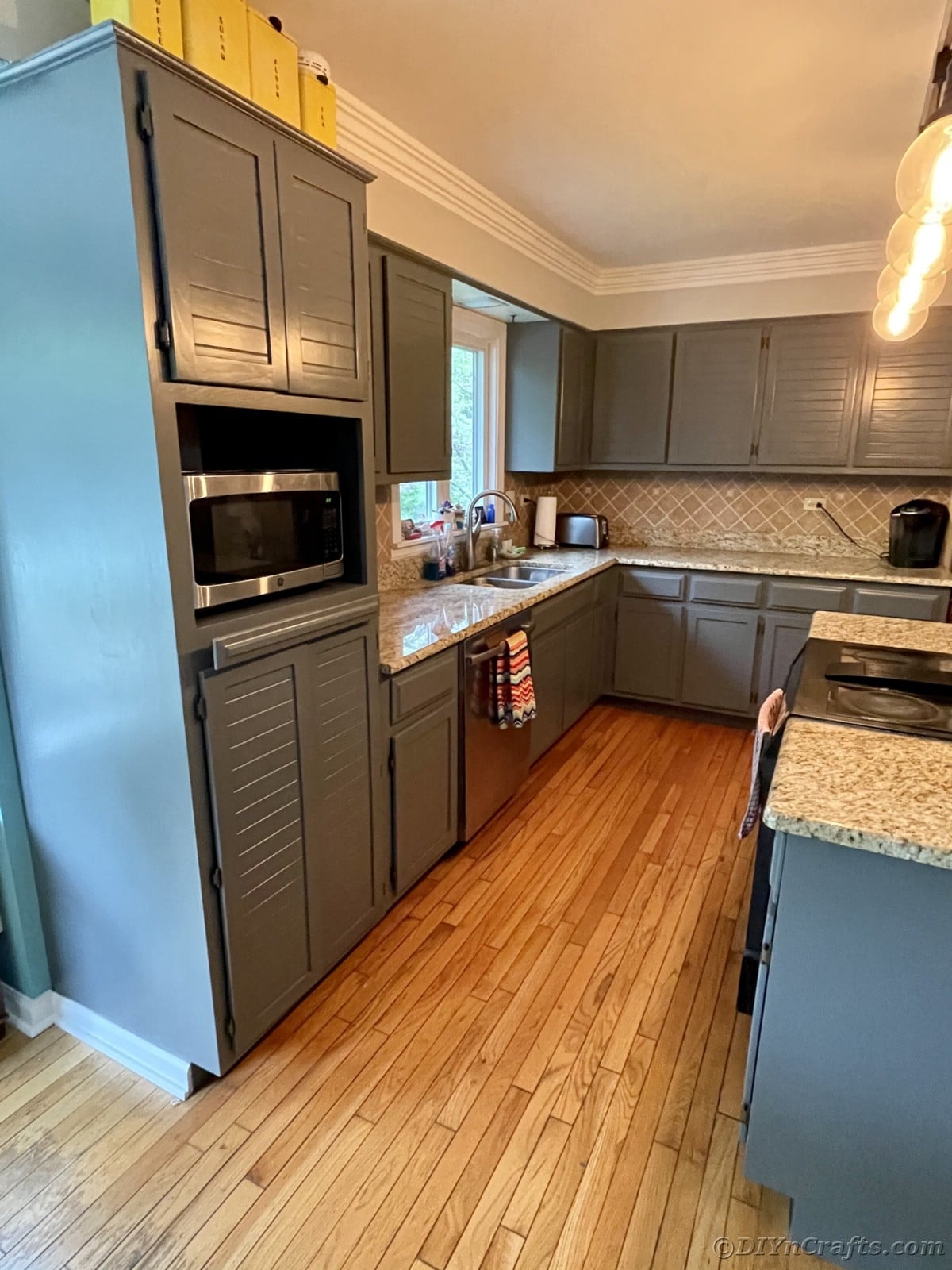
Accent colors around trim can be a great idea if you aren’t looking for that monochrome look.
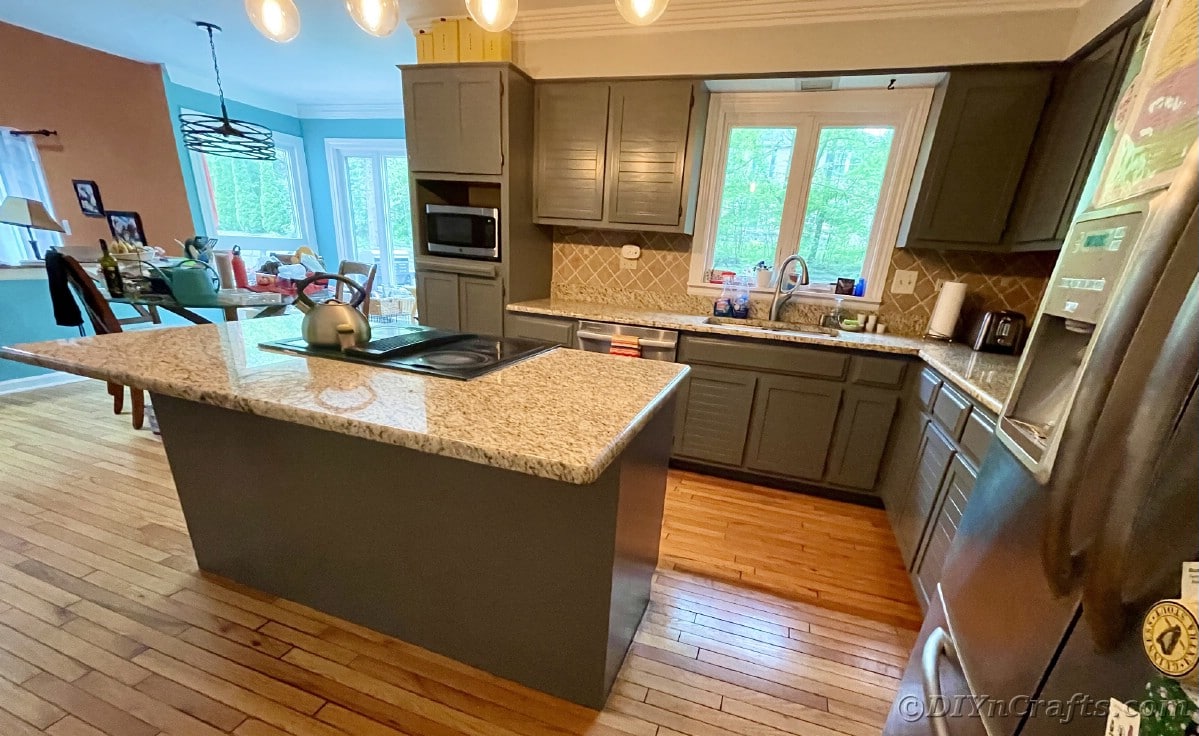
I love how the white crown molding pops against the gray cabinets so beautifully!
